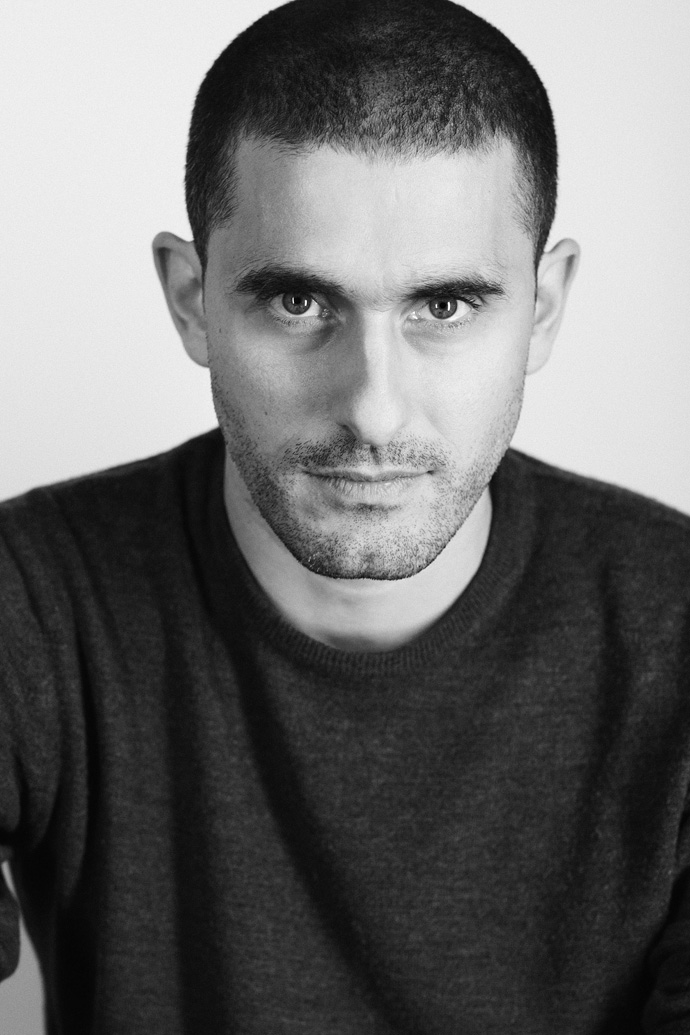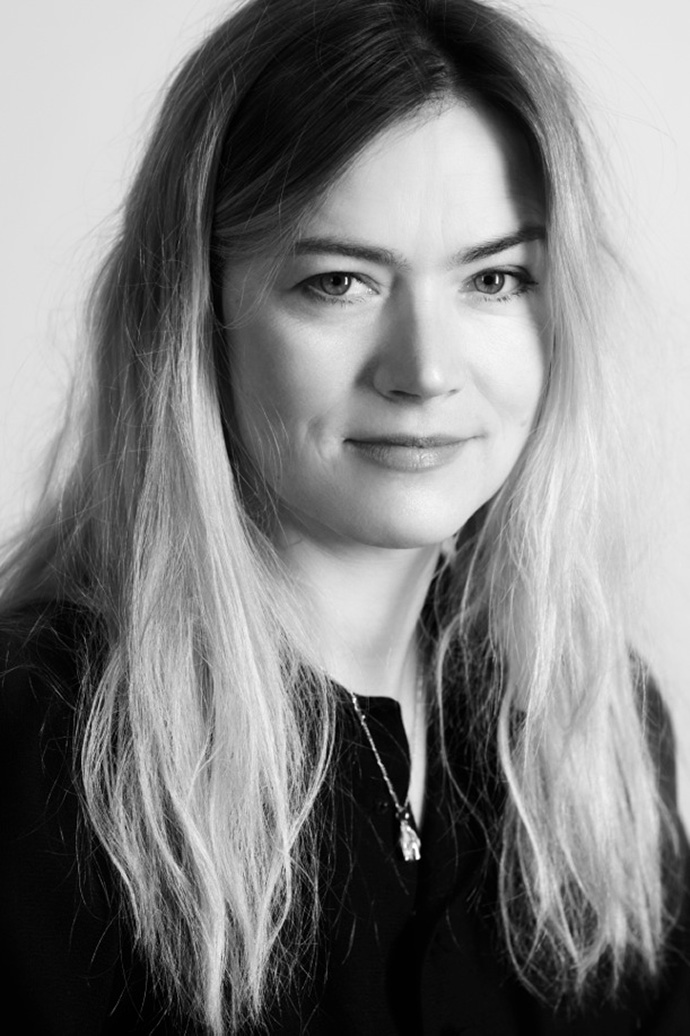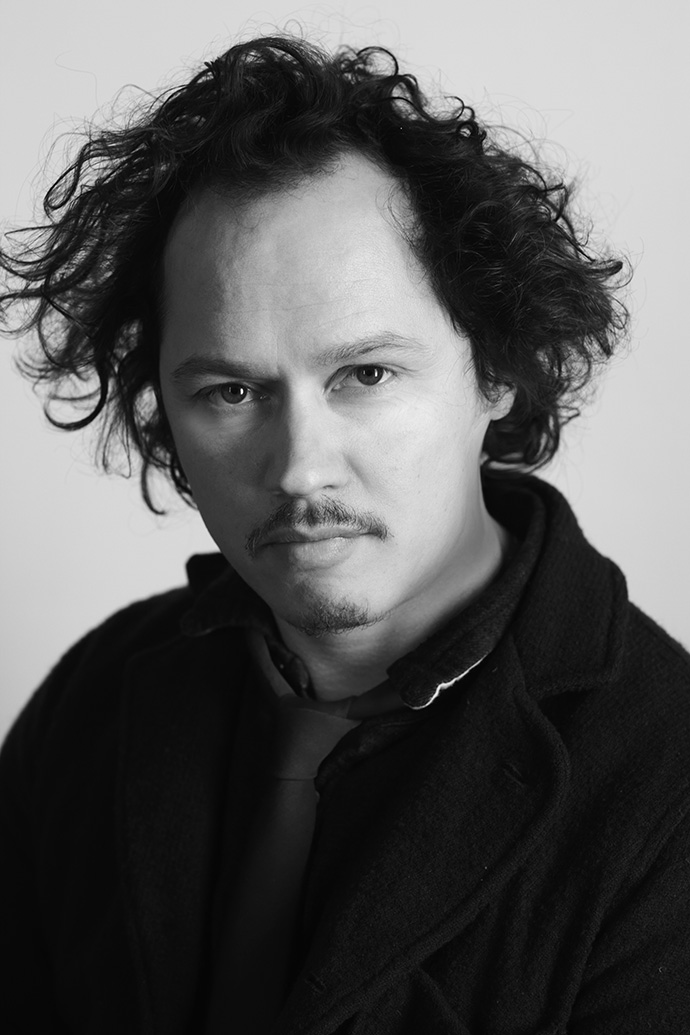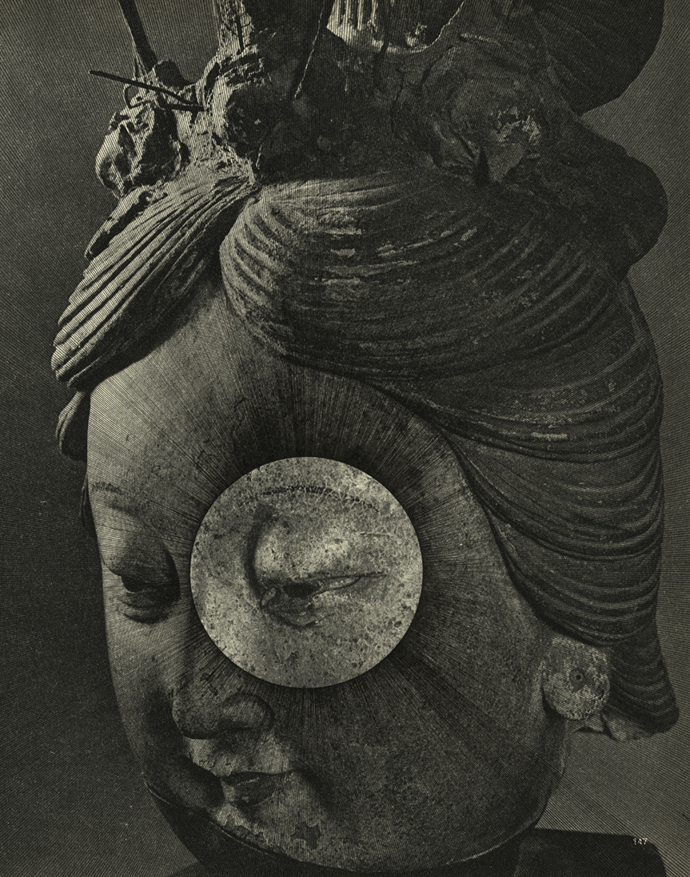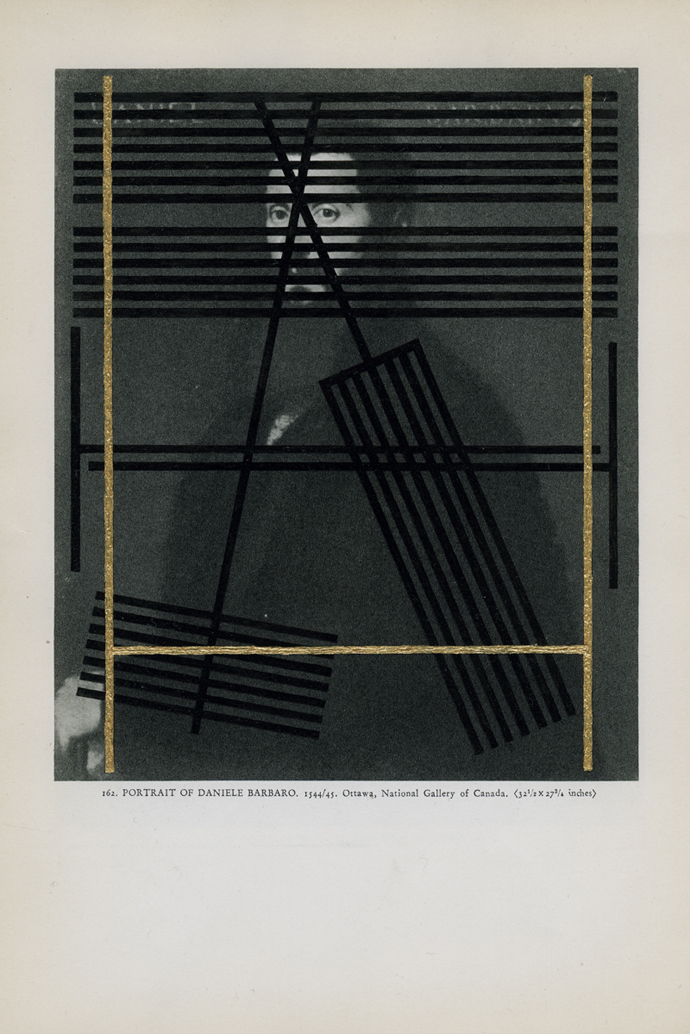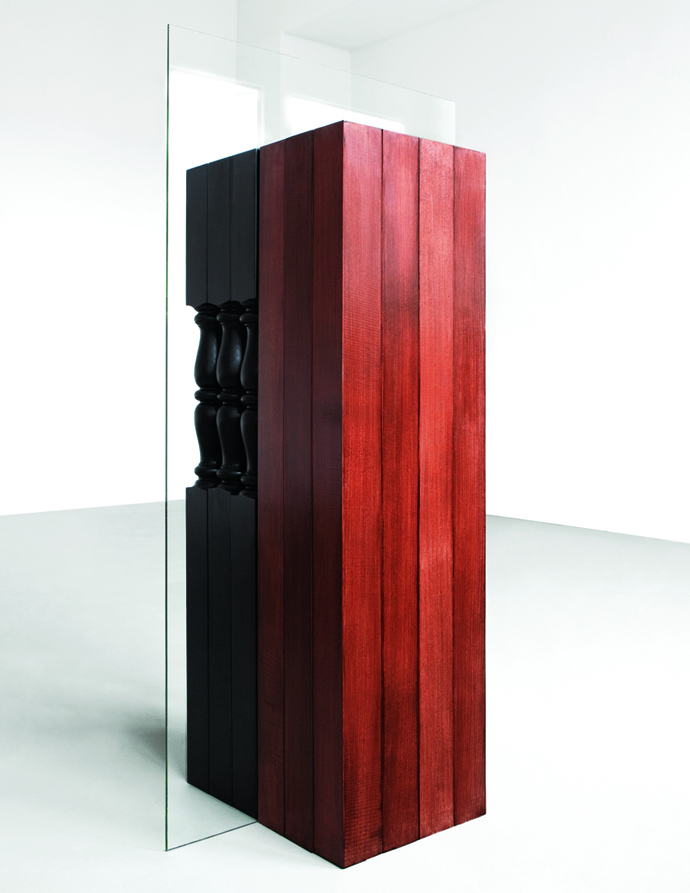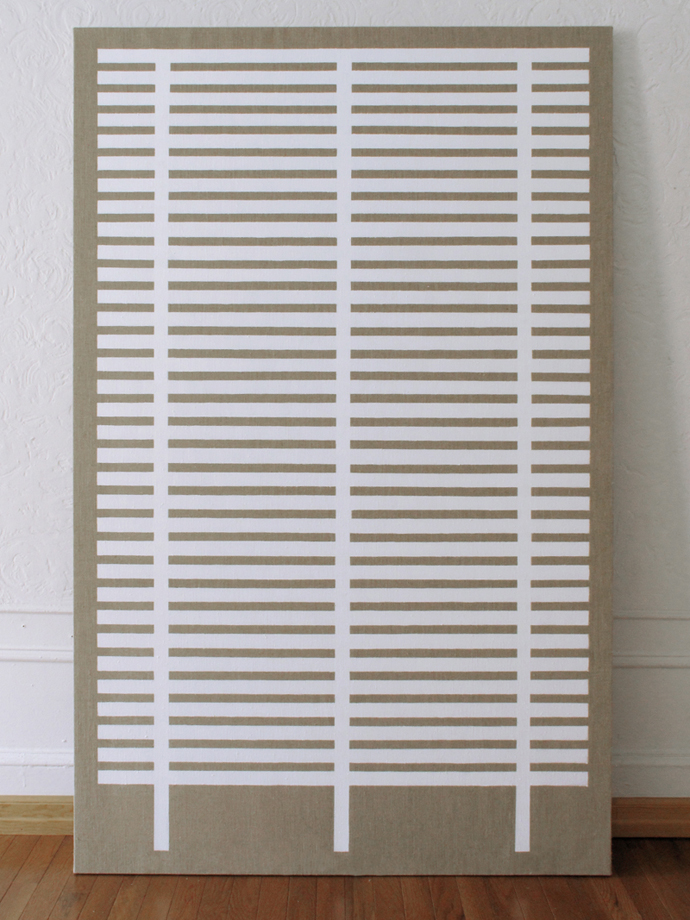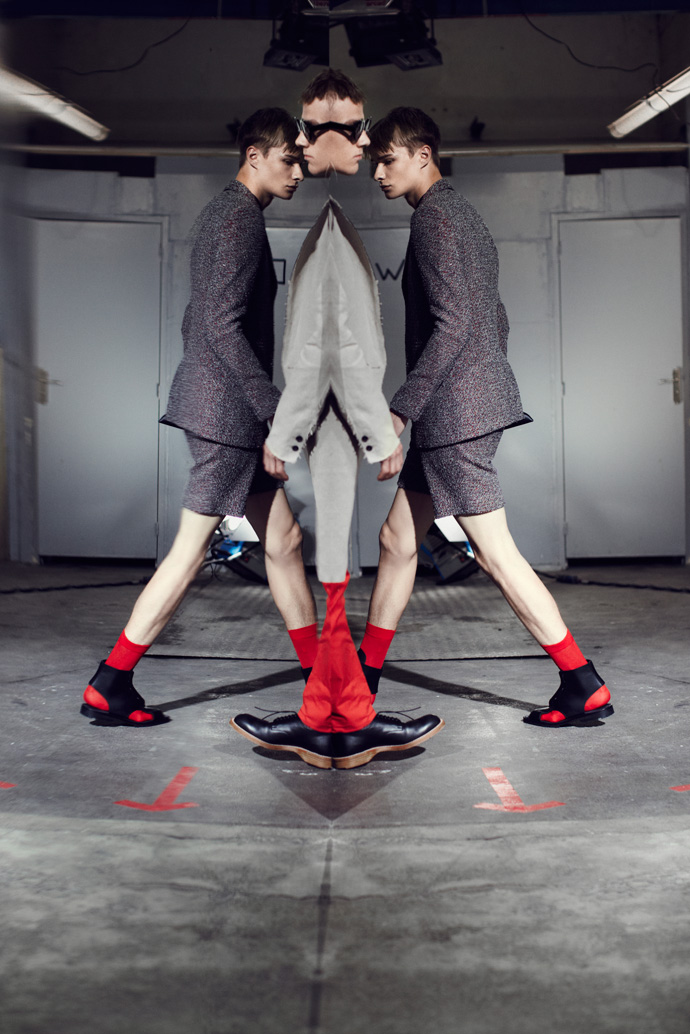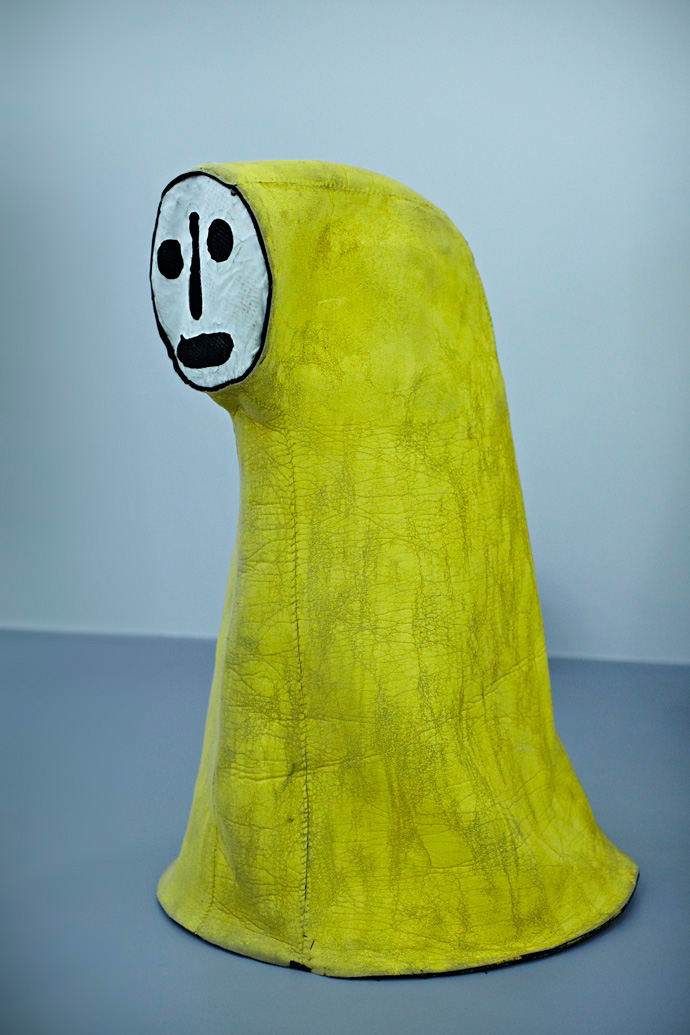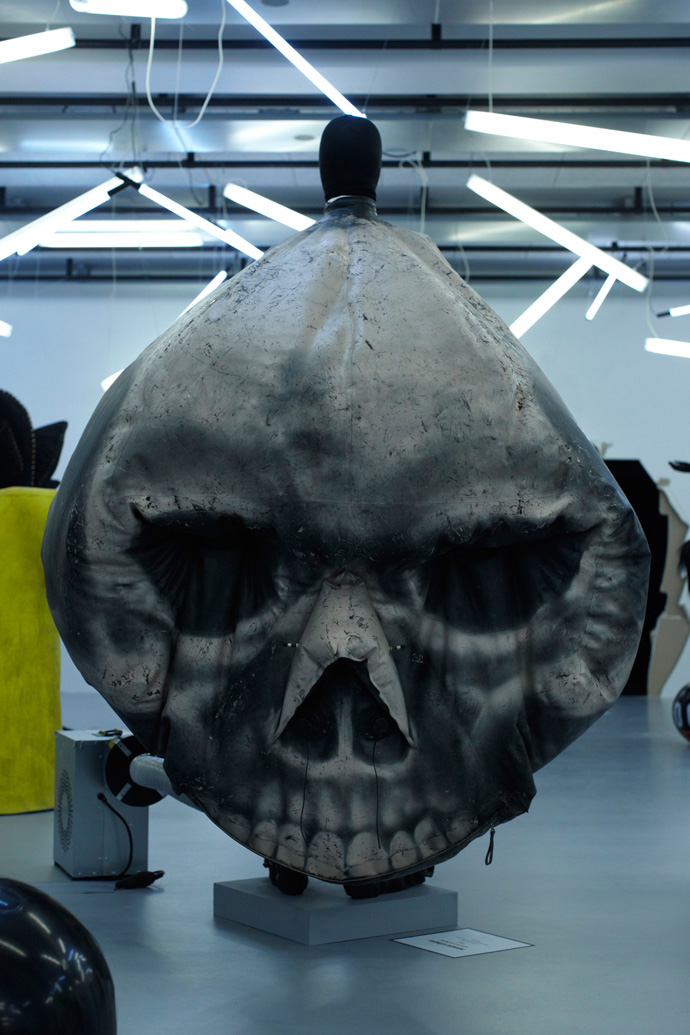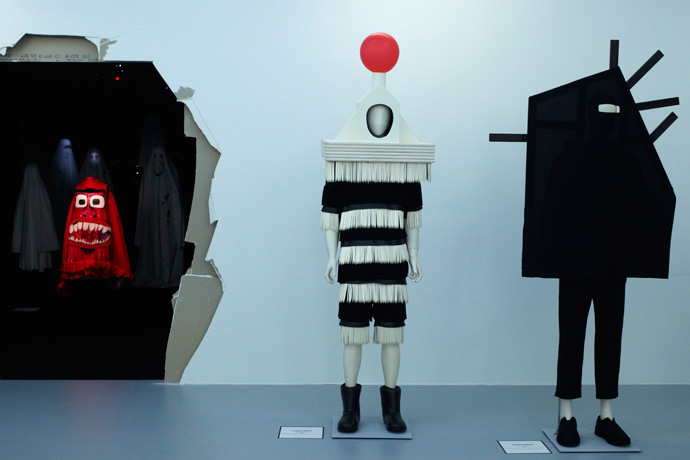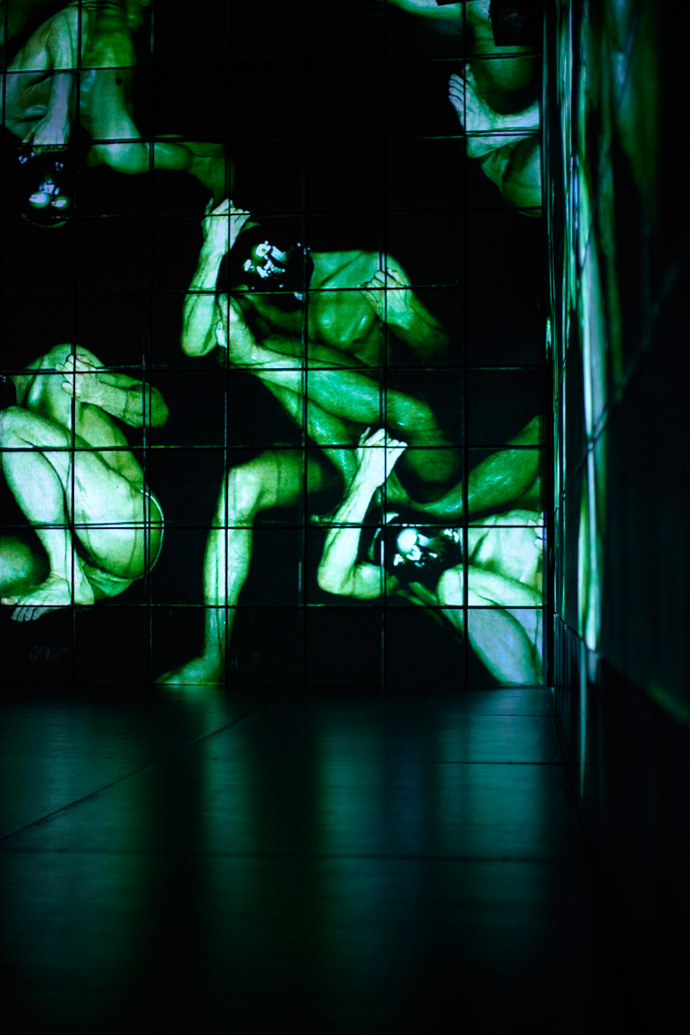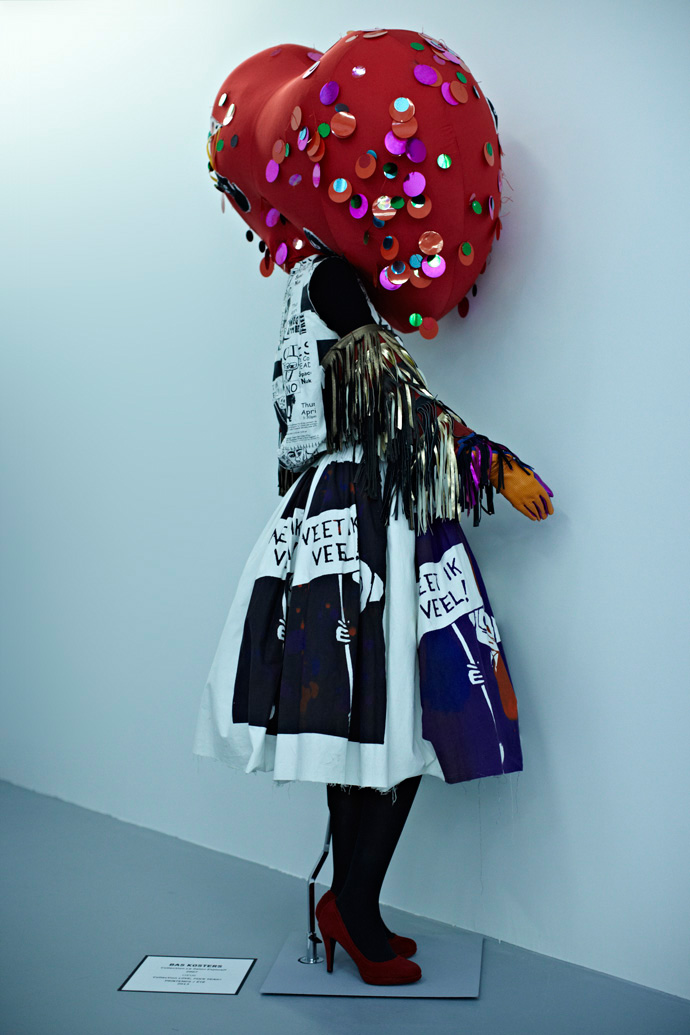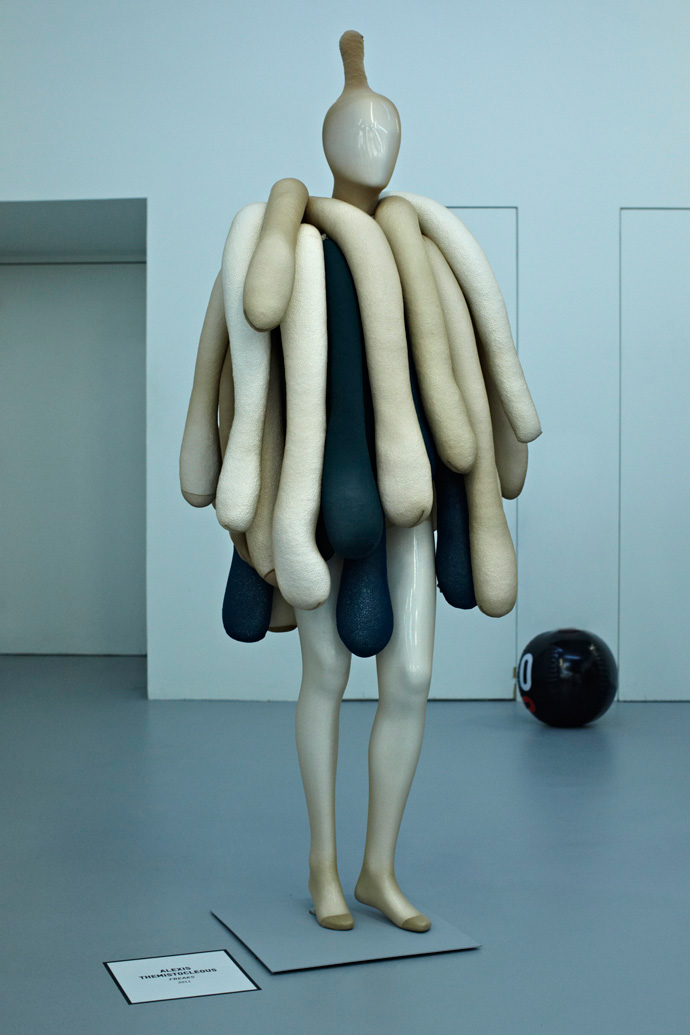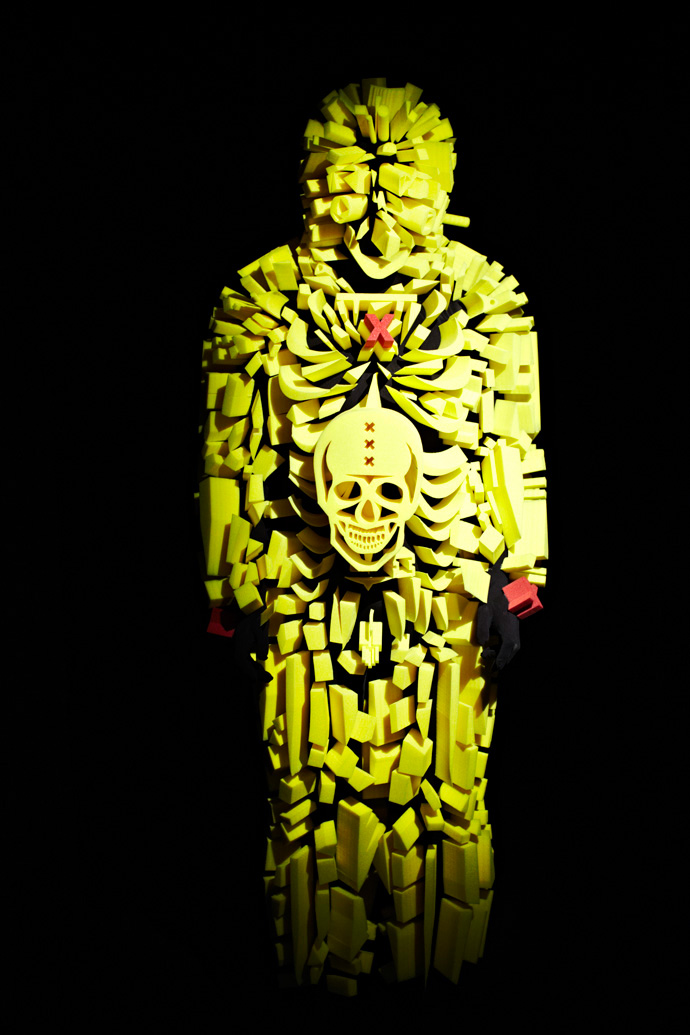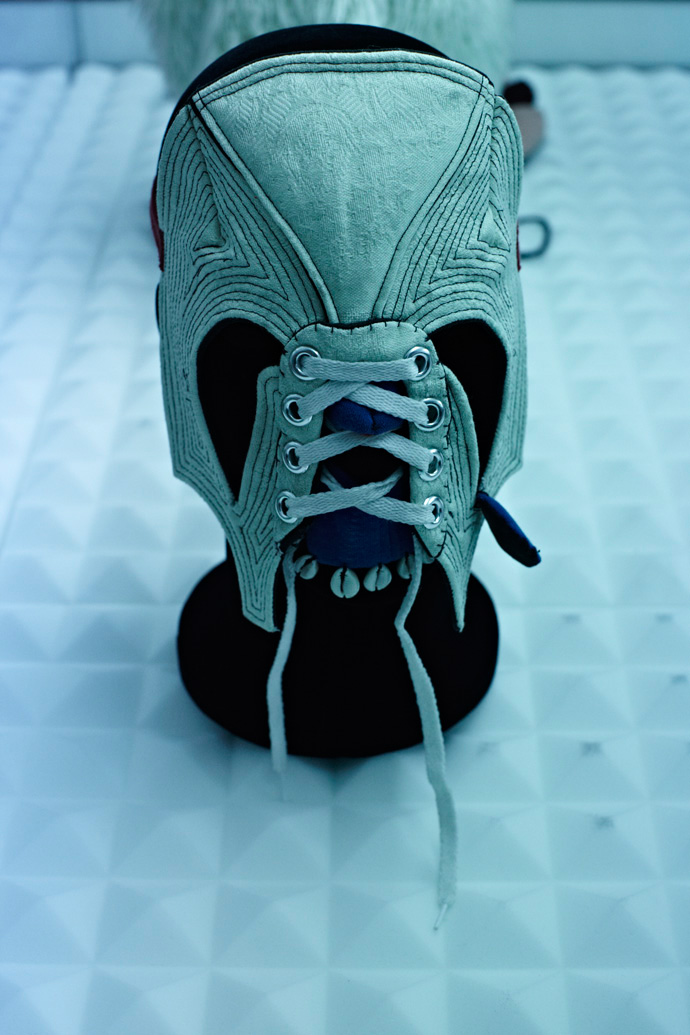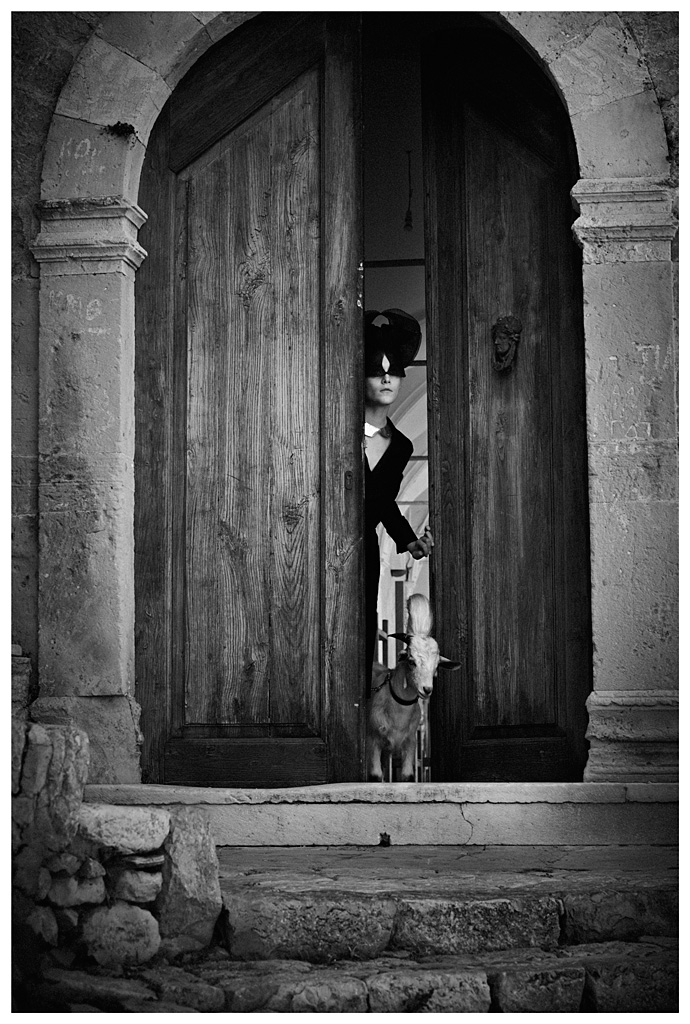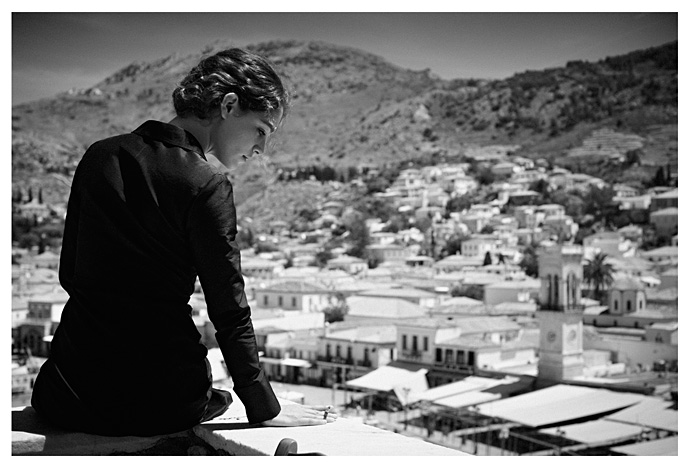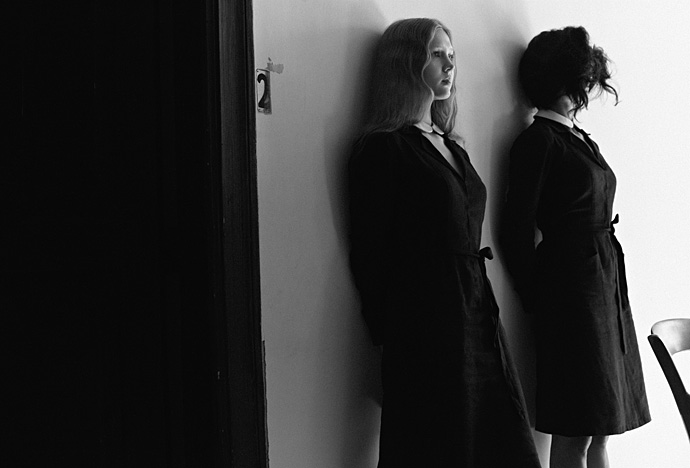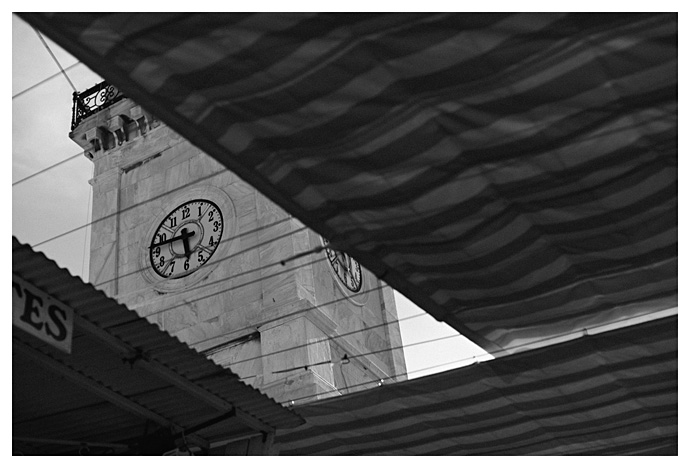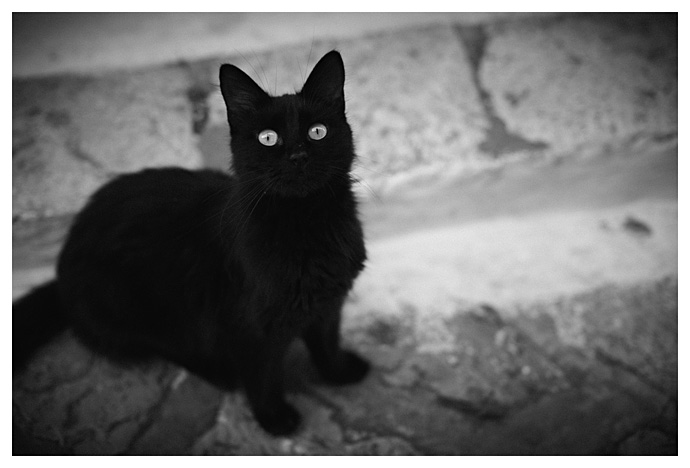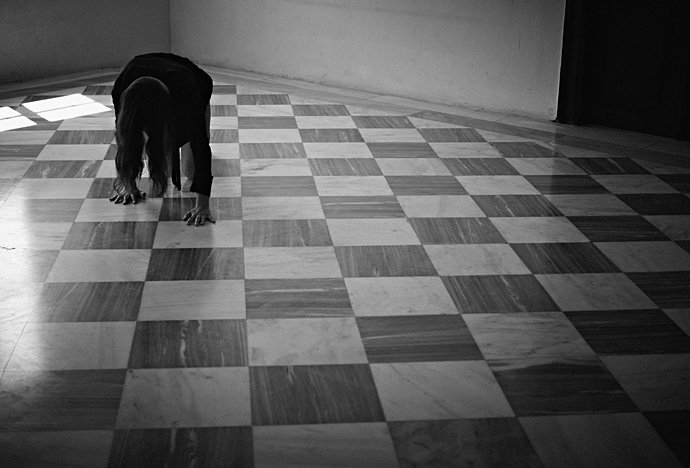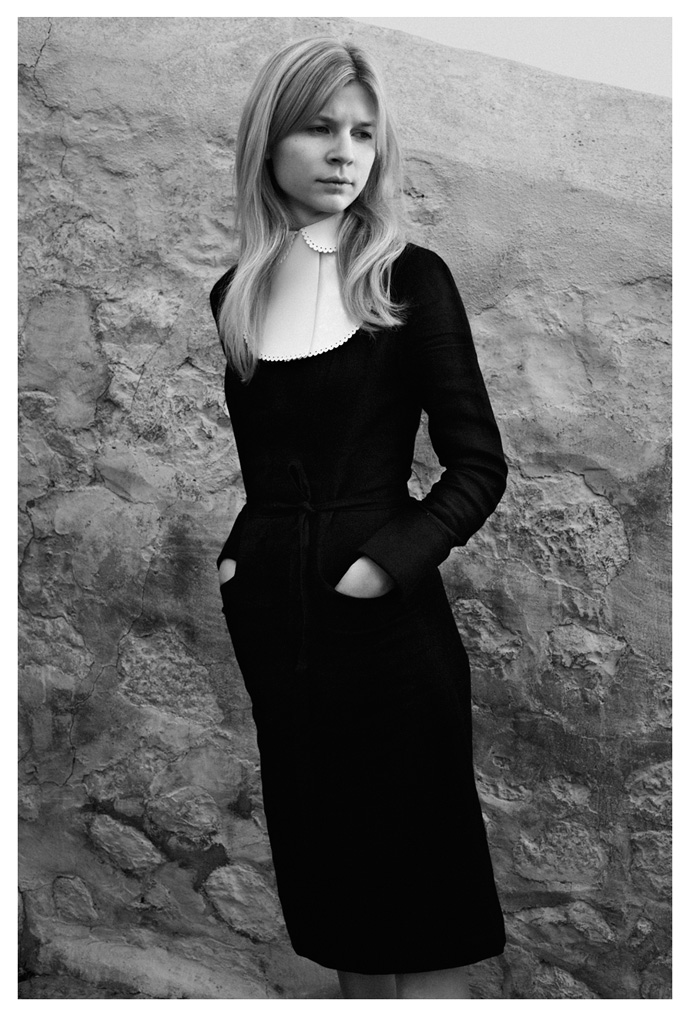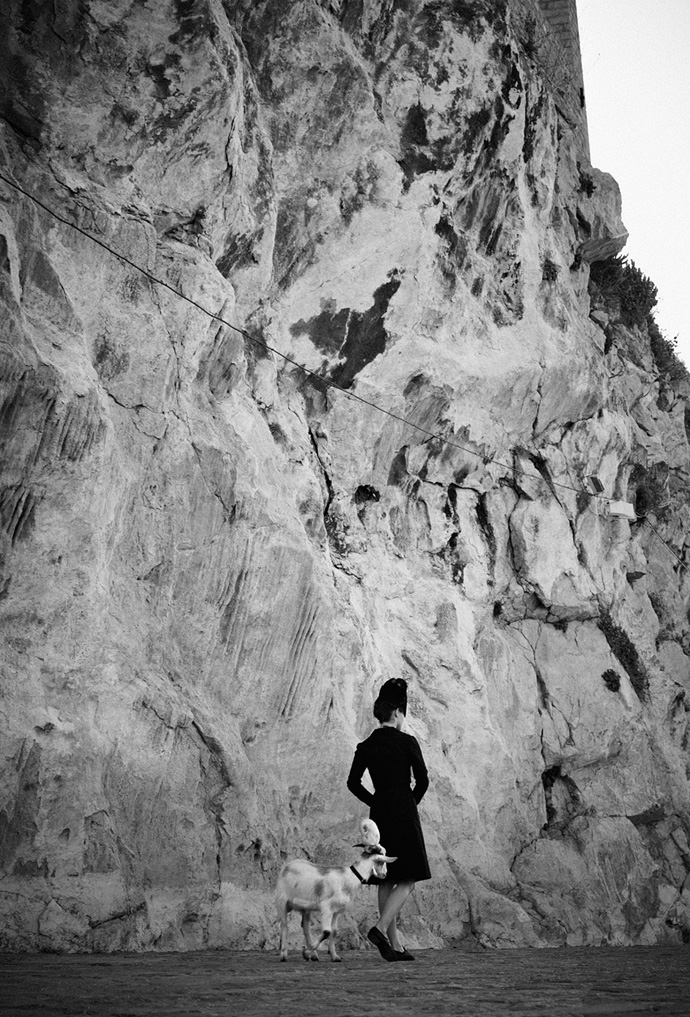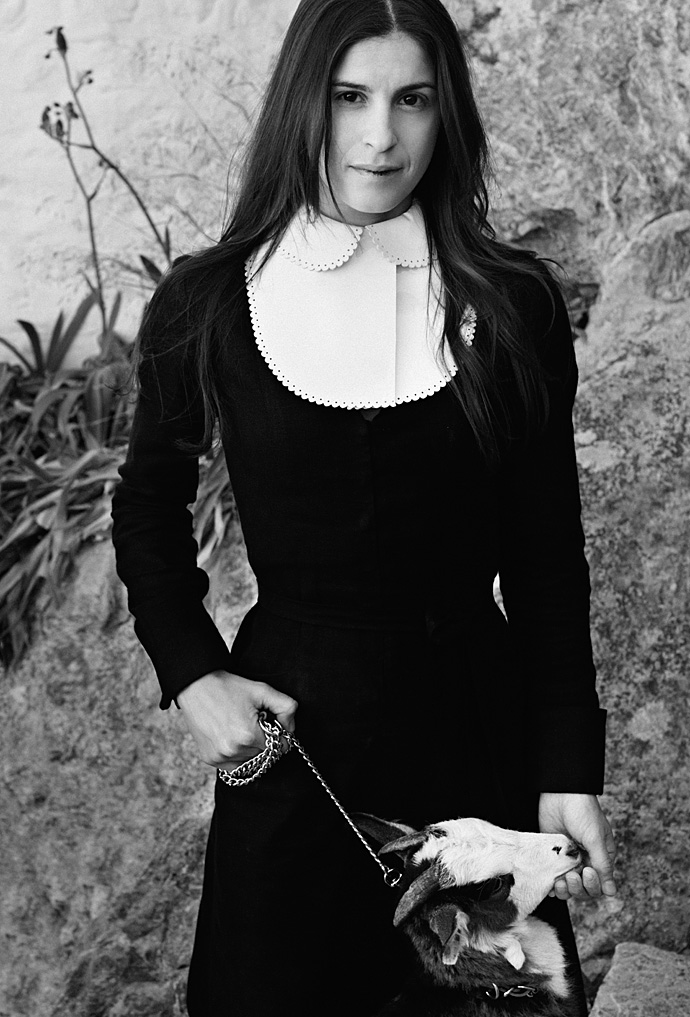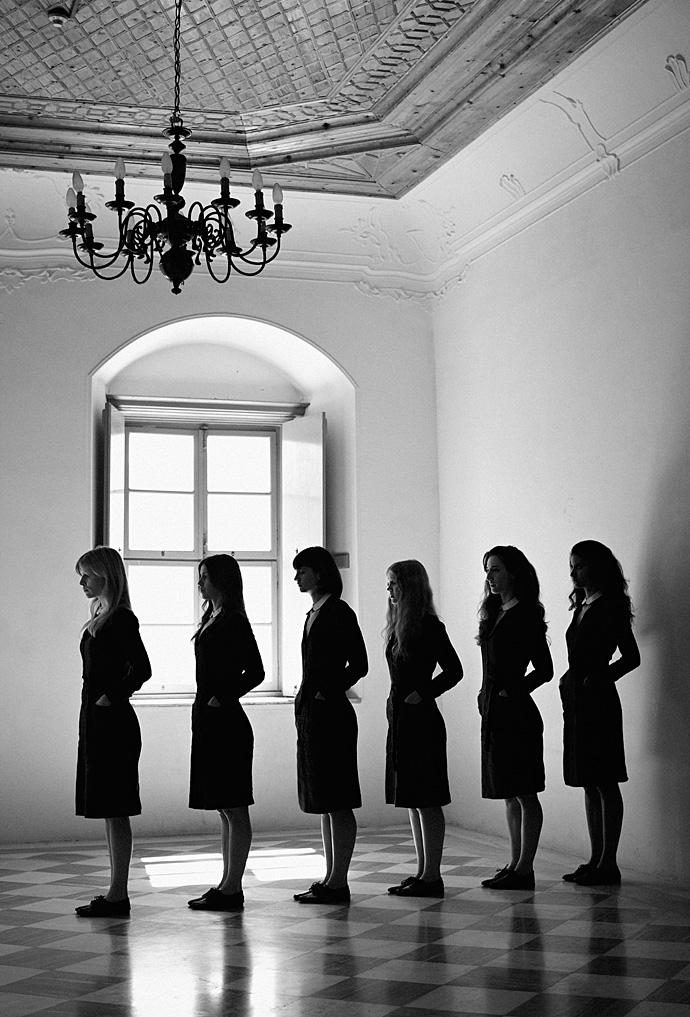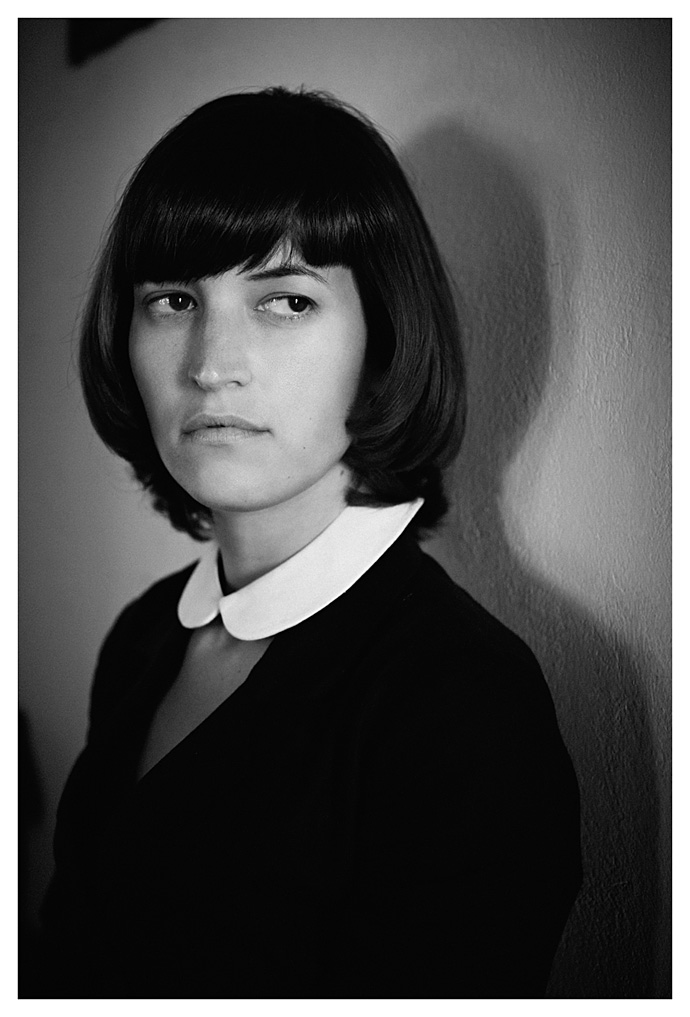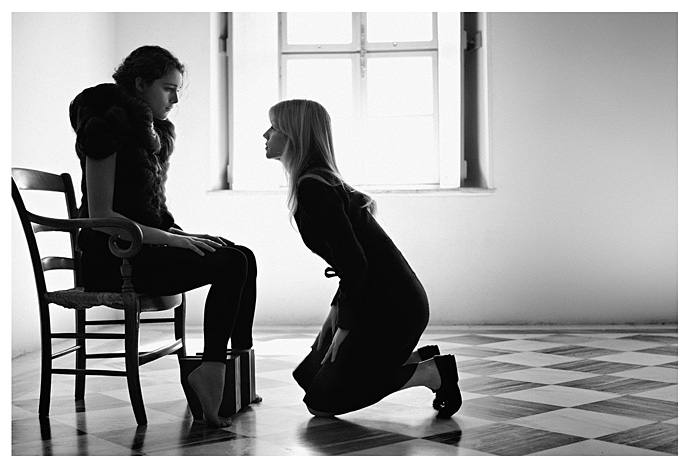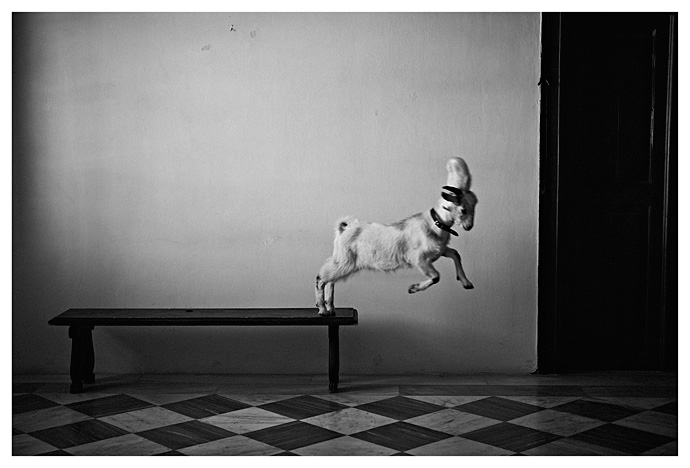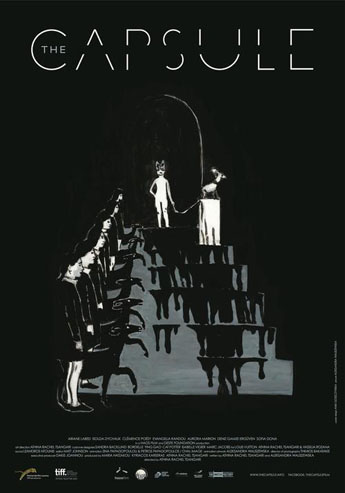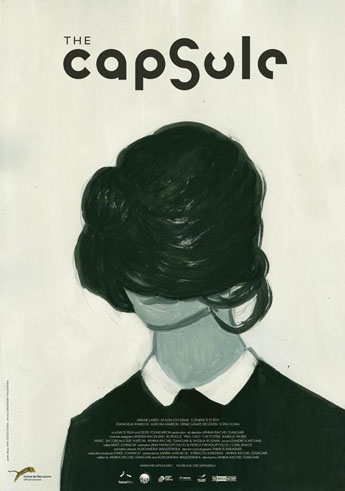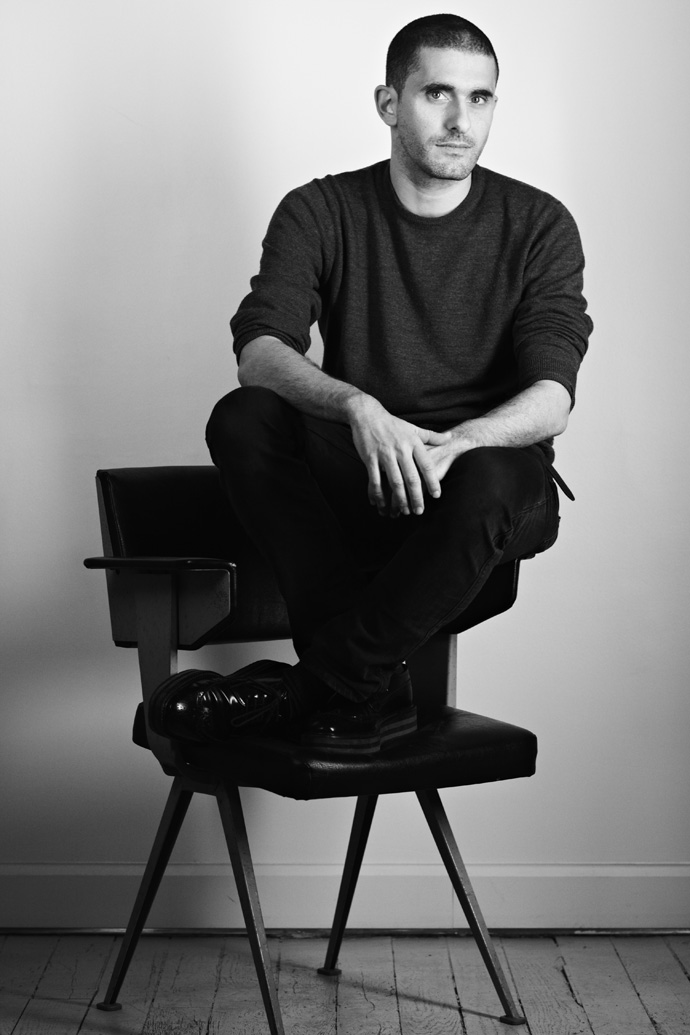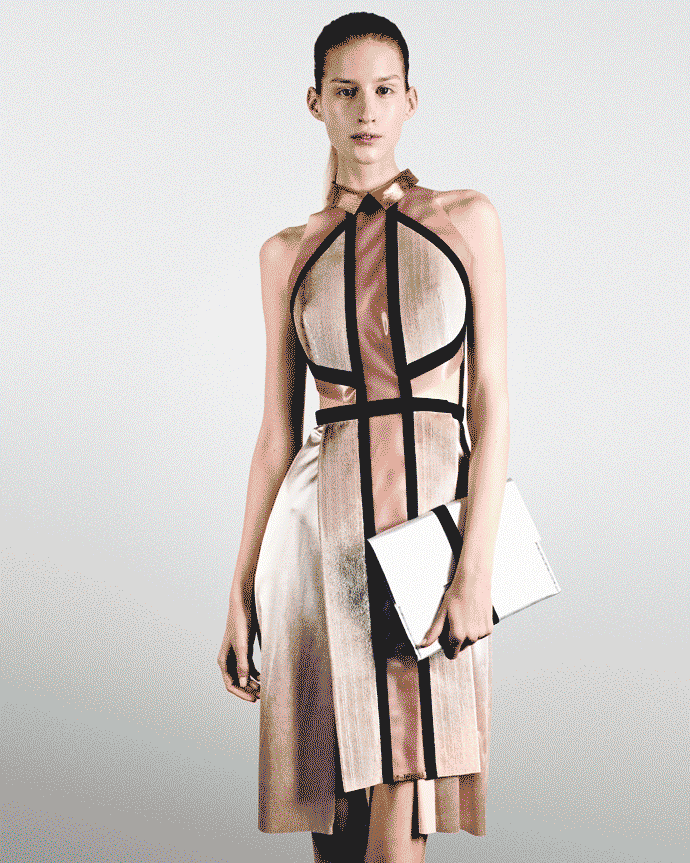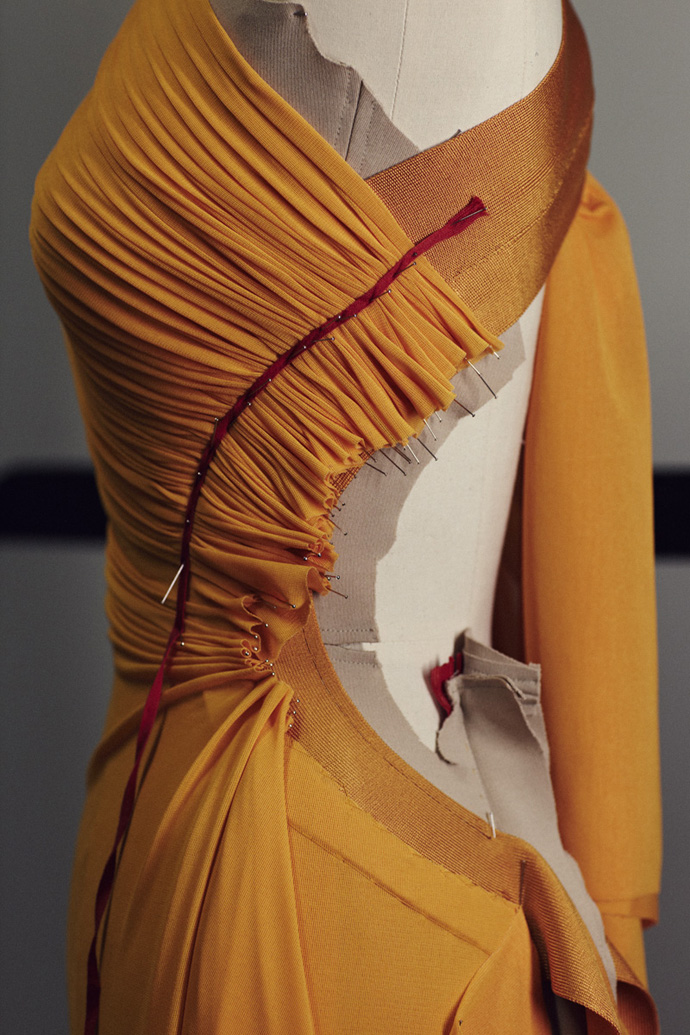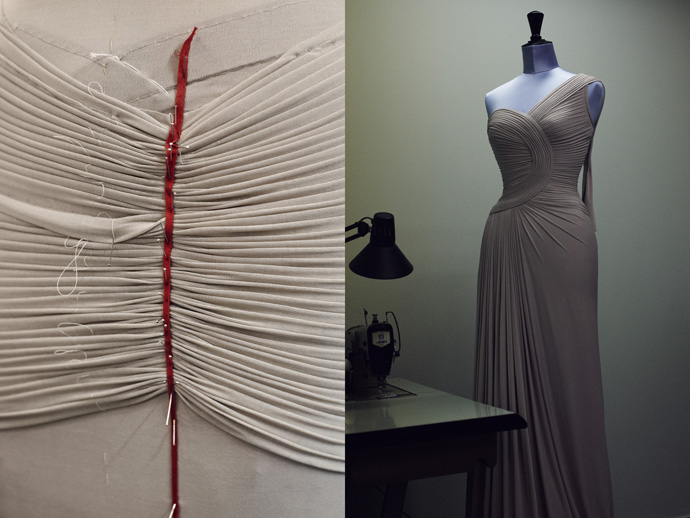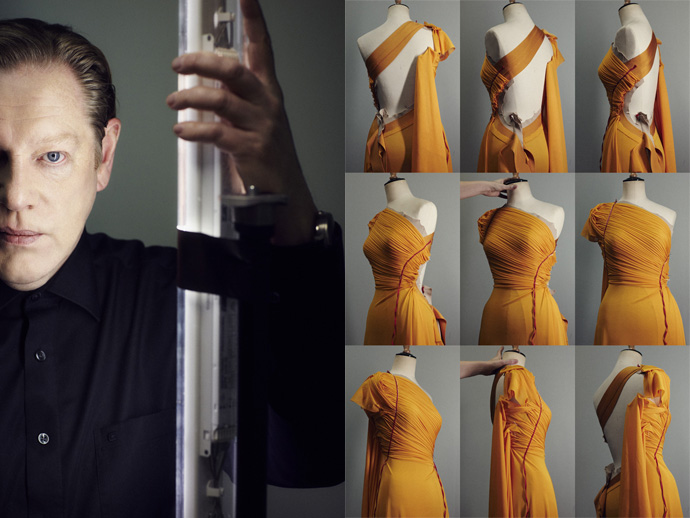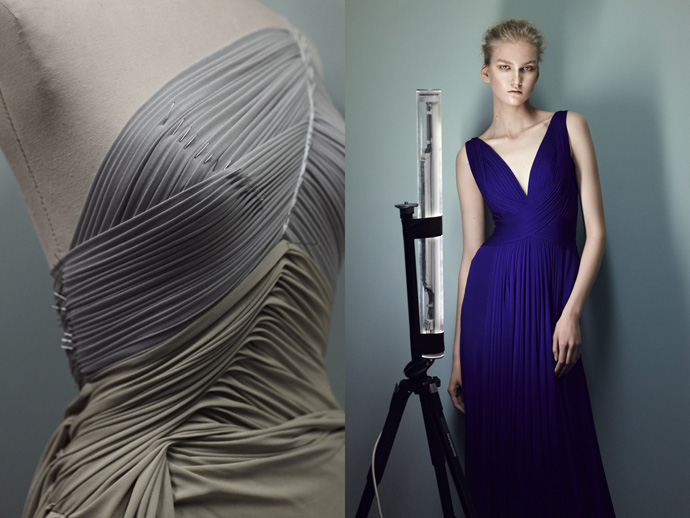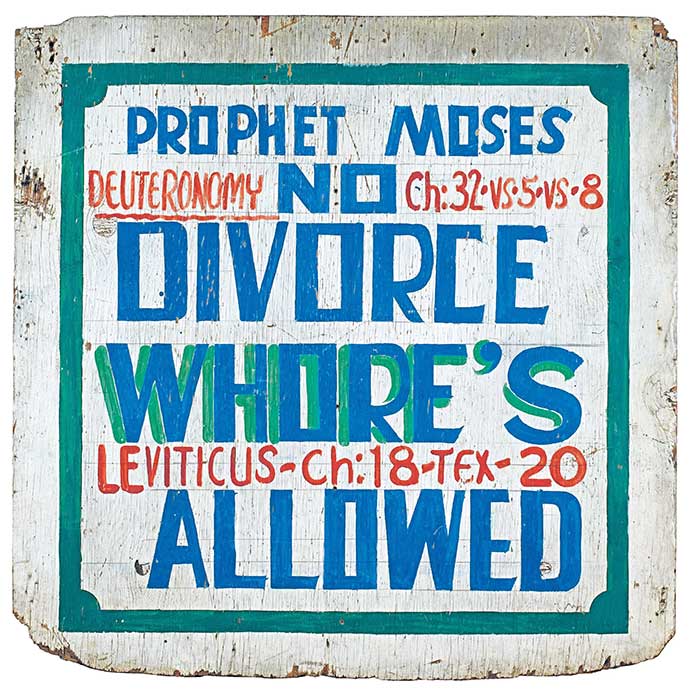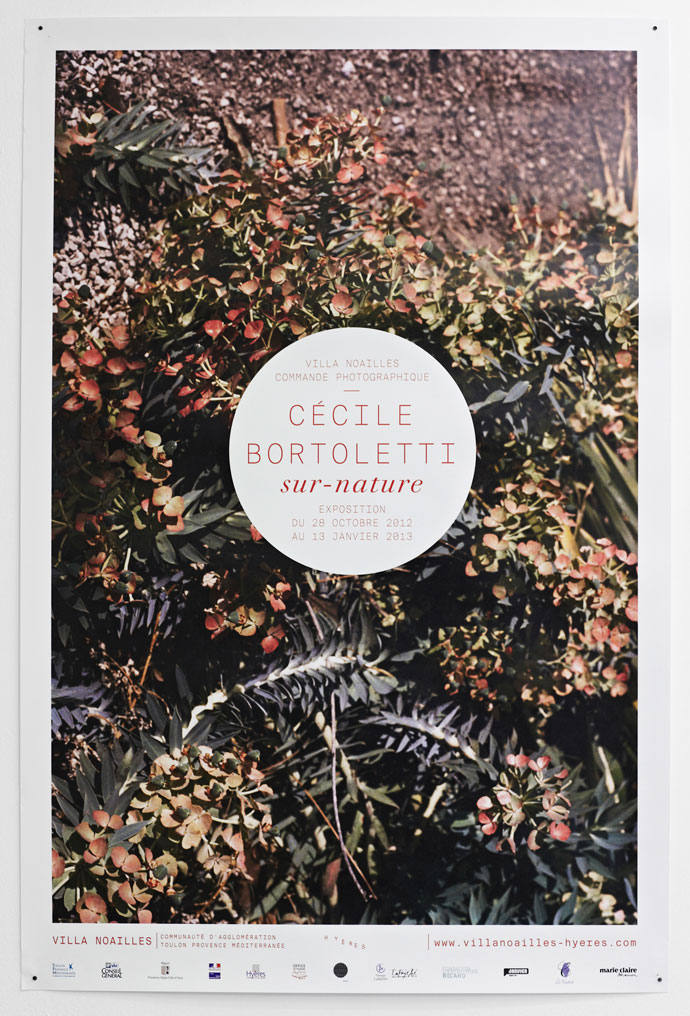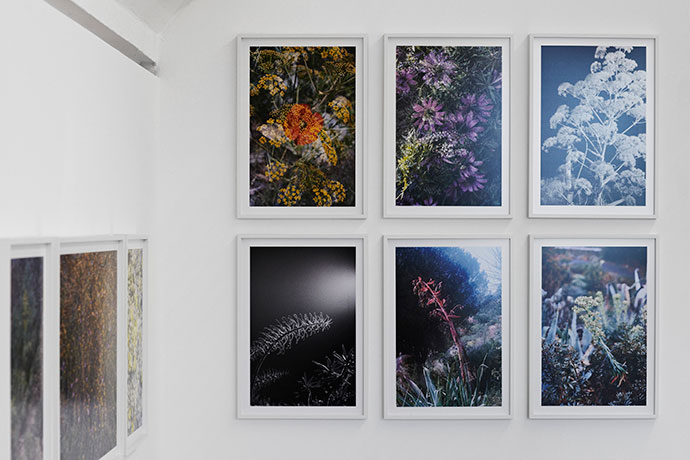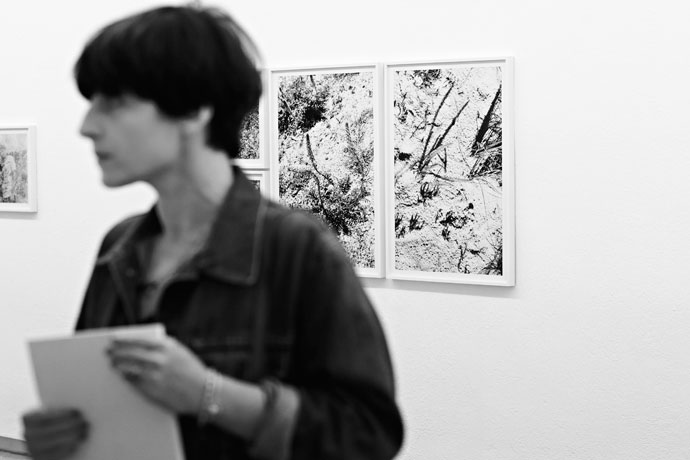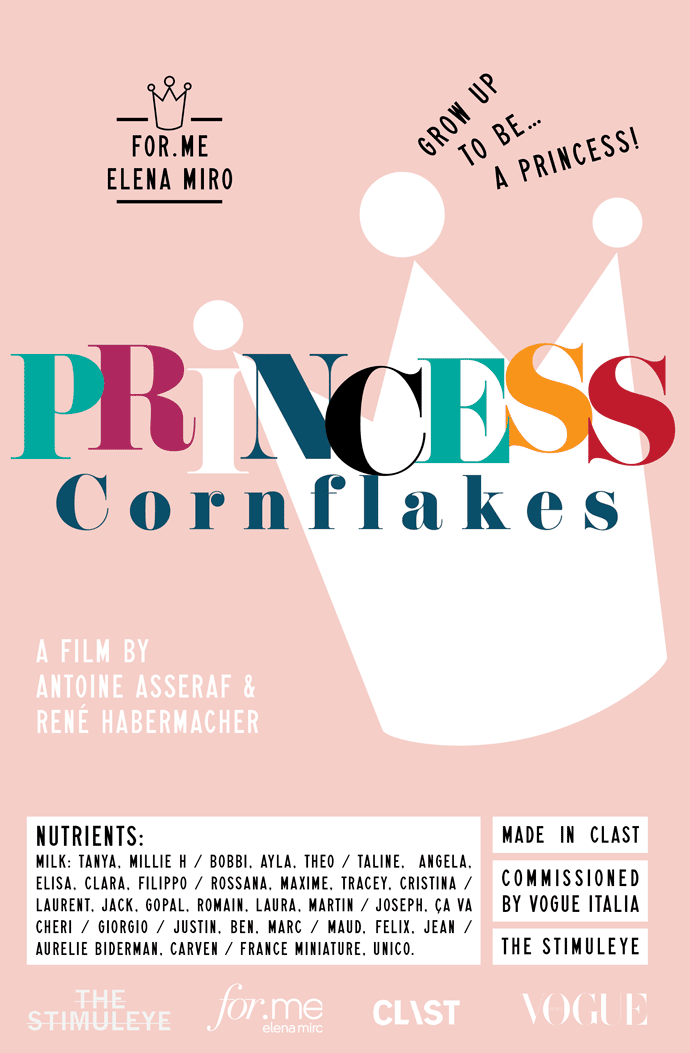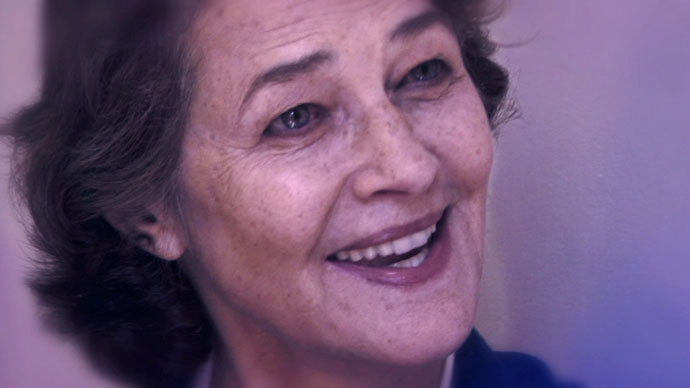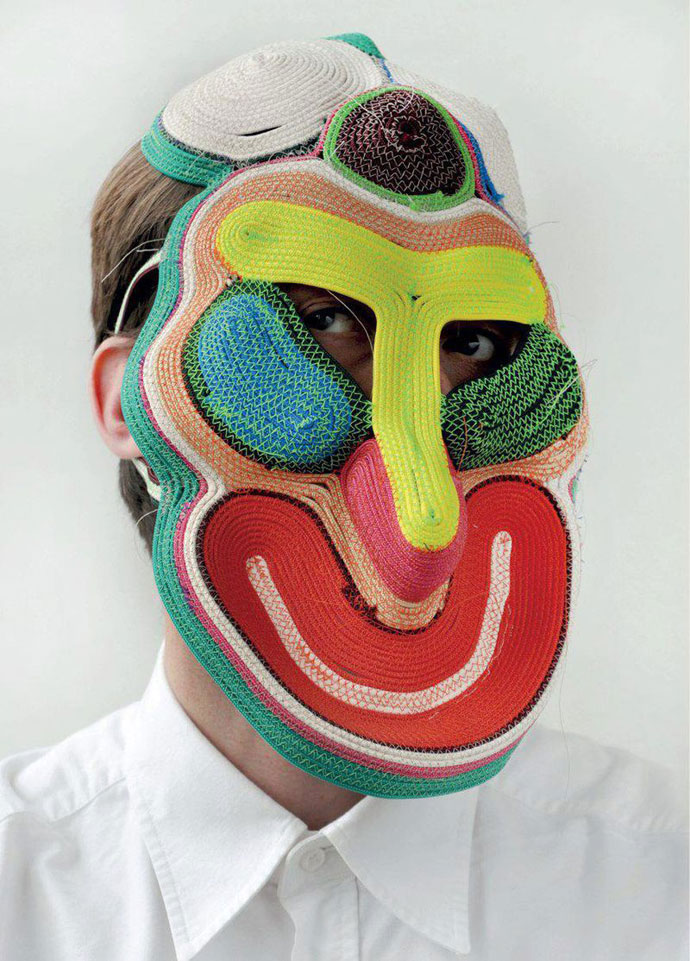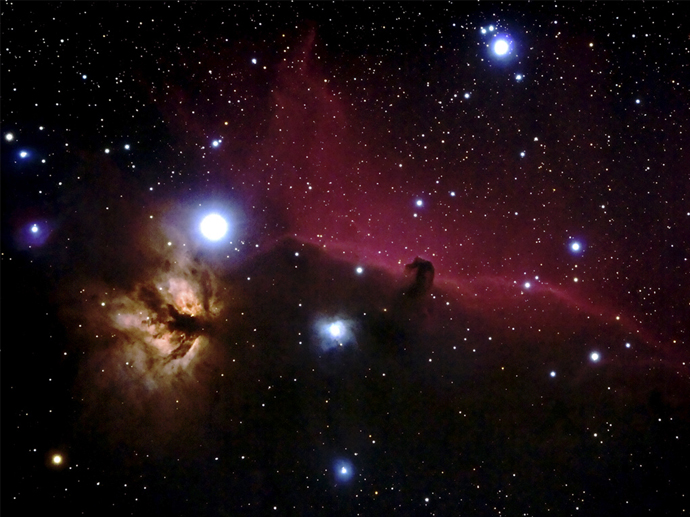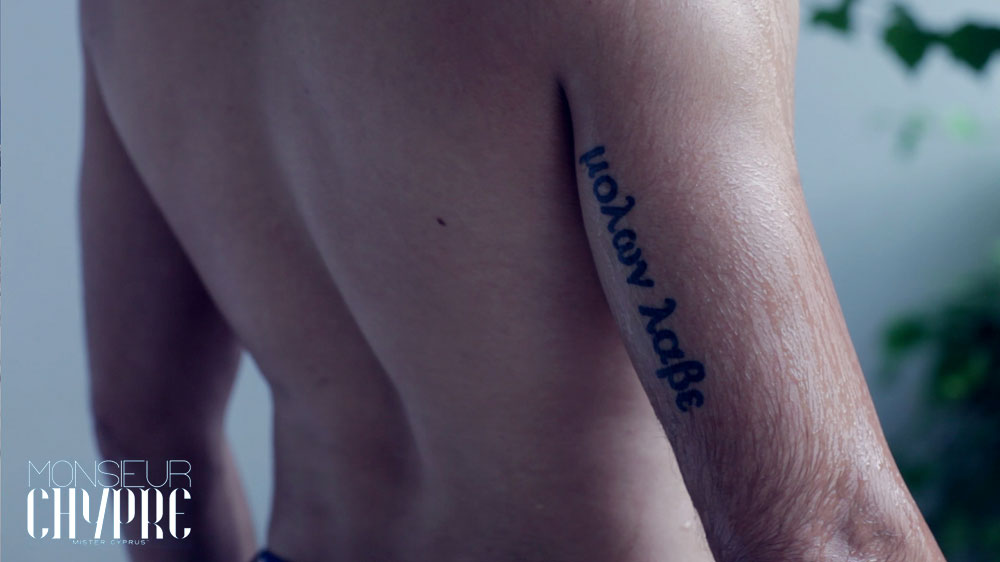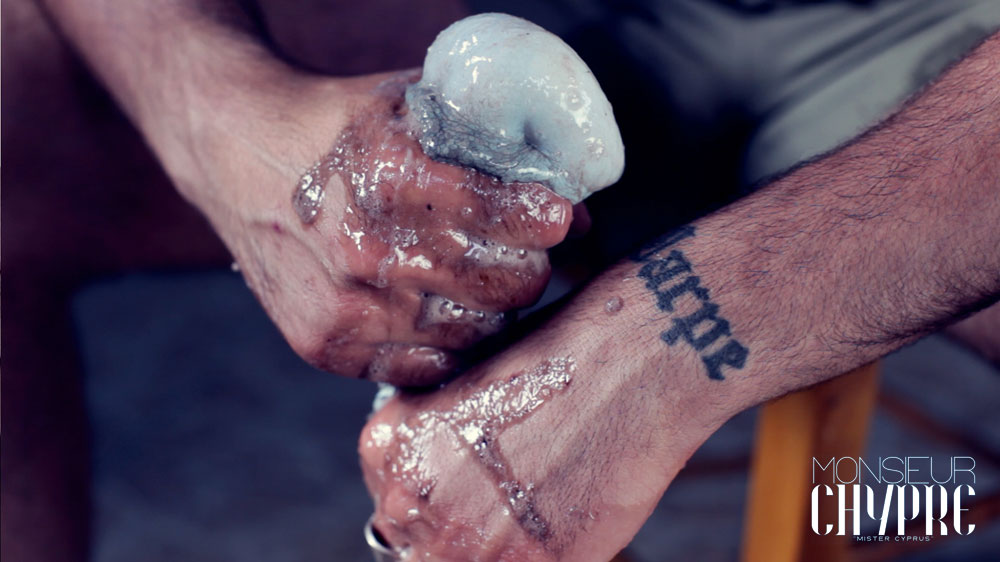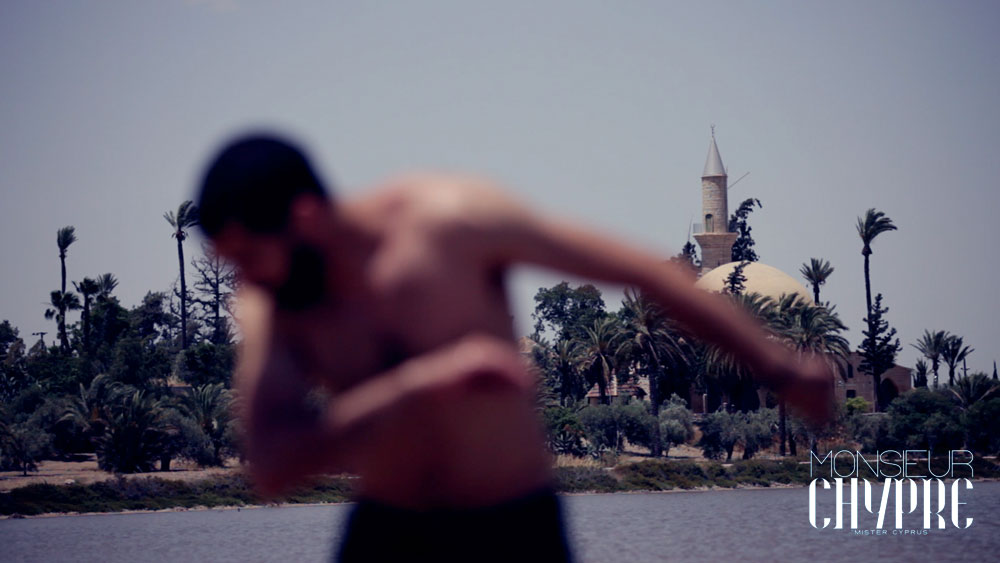-

hyères express: felipe oliveira baptista
-“a screen to the brain” is what Felipe Oliveira Baptista wants to show us in Hyères.
Winning the Hyères award in 2002, then the ANDAM Award, “FOB”, as he is nicknamed, made himself a name showing in Paris over the last 10 years, and is now also the creative director of Lacoste.
As he prepares his return to Hyères, this time as Jury President, he faces the inquiries of our team of bloggers…
Felipe Oliveira Baptista by René Habermacher.
Filep Motwary: If I asked you to look back to the beginning of your career and compare how the industry worked then to how fashion functions today, what would you say are the biggest changes?Everything has speeded up a lot, more collections, pre-collections, collaborations & capsules. Internet gave way to a whole new way of spreeding new talent, ideas and concepts. it is a very different landscape from the beginning of the century. On the other end, we seem to live in an era where there is too much of everything and by the time something new is found, it is already finished.
Warhol’s 15 minutes have turned into 15 seconds.
Antoine Asseraf: Winning Hyères + Winning the ANDAM + Consulting for other brands… is that the only path for French-based designers to establish themselves today ?
I think Paris is the toughest fashion week for a youg designer. Between all the big houses and a strong presence of other international designers, it makes the spotlight smaller; so Hyeres & the Andam are a great help to get your name out there.As for working for other brands, if you are independent and do shows, it is almost mandatory.
Sean Santiago: How do you keep a sportswear brand such as Lacoste relevant on an international scale, and is international appeal vital for a successful brand? Where does that appeal come from – catering to diverse markets or maintaining a uniquely French aesthetic that people find desirable?Lacoste is relevant on an international scale with more than 1500 shops world wide. We create a base and main message through the show collections, pre- collections and advertising campaigns, but there are regional adaptations done to answer local needs.Bruno Capasso: You being Portuguese felt any difficulties to enter in the market, even though you have a British training? What do you think of Portuguese fashion today? Which are the things that need to be improved so they have more global approach?I don’t know…I do not think my nationality went for or against me, I believe individuality is stronger than one’s nationality.
Vogue.de: You are going to have an exhibition at Hyères as well. What are you going to display?“A screen to the brain” is an installation made of 100 different sized screens that go through the creative process of a collection: references, collages, drawings, videos to the pages of fashion magazines.
This installation will evolve and will be shown again in a FOB exhibition starting next october in MUDE, Lisbon.10 -

hyeres express: maurice scheltens & liesbeth abbenes
-“The specialty of Scheltens & Abbenes is to meticulously arrange objects” claims the biography of photography duo Maurice Scheltens & Liesbeth Abbenes. Working since 2002 as a duo, the minimalist compositions they painstakingly compose have earned them attention from clients and editors alike.
As part of the Hyères 2013 Fashion Jury, they answer the questions of the blog partners – Un Nouveau Ideal by Filep Motwary, *Fruitpunch by Sean Santiago, BRRUN by Bruno Capasso, Vogue.de, Malibongwe Tyilo and The Stimuleye, of course.
Liesbeth Abbenes. Photo by René Habermacher.
Filep Motwary: How does a garment get your attention? What are you searching for while on set?
Maurice ScheltensA sensitivity in material and design. Looking at a garment it often tells if the designer understands it’s own work without stopping to early (or to late) in the process. This attitude is connecting in the way we are also trying to stretch our own sensibilities.Sean Santiago: Your work is striking in its simplicity and for its reductive qualities – is fashion more interesting to you in theory more often than in its execution?
We are more interested in what we see then in what we know or should know. After ‘building’ is the moment of truth. Our curiosity by testing an idea for it’s visual qualities is the driving force. That is also why we keep on searching, experimenting and checking during the shoot instead of making photographs from a sketch made on the drawing table. This doesn’t mean that thoughts or drawings as they are can be beautiful and interesting to. It’s a matter of where to put all these aspirations.
Maurice Scheltens by René Habermacher.
Antoine Asseraf: As jury members used to shooting Fashion as objects, can you abstract the mise en scene, the show, the person to judge only the garments ?
Actually we see the same struggle and solutions in the garments as we face while shooting fashion or any other object in front of the lens. Maybe it’s a healthy distance that we have looking at fashion because we’re not ‘over informed’. We’re responding to what we see with the same critical eye as we do in our own work.
Bruno Capasso: How do you work as a duo – do you have 2 distinct visions ?
Our collaboration has been growing over the past ten years. It’s an evolution in which we grow individually towards each other and makes it difficult to say what comes from who. Individual credits would be out of place. See it as a chess game in which one makes a move and the other responds onto it… on and on.
-

welcome to marie laure’s
-The Stimuleye is proud to present the Hyères 2013 teaser trailer – Welcome to Marie Laure’s, starring Suzanne von Aichinger as the reincarnation of the legendary Marie-Laure de Noailles. Of course.
International Fashion & Photography Festival 2013
Hyères – TeaserApril 26 – 29, 2013
Villa Noailles, Hyèreshttp://www.villanoailles-hyeres.com/2013/
Film by Antoine Asseraf & René Habermacher
starring Suzanne von Aichinger
as Marie Laure de NoaillesStyling by Suzanne von Aichinger
assisted by Simon Gensowski & Laure GrandonHair by Panos Papandrianos @ CLM UK
Make-up by Min Kim @ Airport AgencySound design by Ca Va Cheri
-

davide balliano
-He works across many mediums, makes work and research constantly and needs to have a lot of order in his life.
New York-based Italian artist Davide Balliano had a conversation with me about his artistic trajectory, his work, rock climbing, his influences, his love of intervention and his first show in Paris at the Galerie Michel Rein.
Davide Balliano UNTITLED_Woman V Ink on book page 21x26,8 Cm 2013 Courtesy: Michel Rein Gallery, Paris
Lynsey Peisinger: Tell me a bit about your life and your path as an artist.
Davide Balliano: I was born and grew up in Torino, in the northwest of Italy. I was there until I was 18 and then I started in high school studying advertising and graphic design. It was a very peculiar school, a very specific school, which had a lot of elements that are still useful for me now. Especially the graphic design elements, the study of the image, the history of the image, art history. All of that is still informing my work today.
After that, I moved to Milan where I studied photography at Bauer, which is a fabulous school of photography. It is probably the last public school of photography that is left in Italy. What I liked of the school was the approach that they had, that I think they still have now, where rather than teaching “photography as a job”, they tried to raise us as artists working in the medium of photography. They train you as an artist who used the tool of photography. Then what you do with that tool is your choice.
Two years after school, I went to Fabrica, which is a large artist residence in Treviso, in the north east of Italy, a half hour from Venice. It is a beautiful place. A huge building built by Tadao Ando and there are usually approximately 40 artists in residence. It was very commercial-based. There is not much interest in pure artistic research. It’s more applied art. It was a very good experience–they pay you be there, they give you studio, they pay for all of your materials, they give you an apartment. You don’t have to worry about anything. But, even if it was great, it sort of crushed my relationship with photography. Fabrica had a very strong way of shaping the people that were there, so they were not making it a mystery that they couldn’t care less about the kind of photography that I was doing! I was very young, I was 21.
After Fabrica, I stayed one more year in Milano, then I got badly bored of staying in Italy. So I moved to NY in 2006. And it is in the early time in NY that I started to do other stuff. I felt that this move to NY was sort of giving me a clean cut from everything that I did until then. I sort of put photography a bit on the side and I started to draw and to intervene, but still on photographic images. I assume that because of my background in photography, I always have a difficult time starting anything from a blank background, you know from a white slate. For me, it has always been terrifying!
Davide Balliano UNTITLED_Barbaro Watercolor and acrylic on book page 18x25 Cm 2012 Courtesy: Galerie Rolando Anselmi, Berlin
LP: How did you start to move into the mediums you are working with now?
DB: So I started to print out images, mainly from the internet at that time. I still collect a lot images just for my inspiration. And I started to draw freehand on them, mainly abstract geometrical mess! Abstract scribbles, nothing with a precise meaning. Pretty soon, it sort of got clear that the issues that I had with photography were still there–even if I am intervening on top, I still had to take care very much of the meaning of the background image.
There are some images that you can just use for their mood, but there are other images that have a precise meaning that carries responsibilities. I think that this is something that you can use but you need to be conscious about it.
I always hate any kind of work in any kind of medium that just takes strong images and slams them there without standing by it. I always find that it’s a very cheap shortcut. It is something that I always hate.
So, then I started to draw on art history images because I felt that they left me more freedom somehow because there is already a big gap. You are more free to relate with the feeling of the image rather than with historical facts. The facts are there and I agree that I should deal with that, but there is a distance so there is a larger filter. So if I make a drawing on top of a portrait of a king, I should probably do research about who it is etc, but I don’t. And most people wouldn’t say “why did you make a drawing on this king and not on another one?”.
If you do the same kind of thing in photography, it is difficult because photography is such a young medium that almost any photographic image is in a historical context. So from there, the intervention grew more and more precise and became more and more essential. So if you take a drawing of four or five years ago, which was abstract and geometrical, but still messy and not so calculated, they sort of condensed somehow and at some point, it felt a need to take this intervention that I was doing on paper and put it on other mediums.
I burned that town just to see your eyes shine Wood and glass 137x48x48 Cm 2012 Courtesy: Galerie Rolando Anselmi, Berlin Photo: Nikki Brendson
LP: Tell me a bit about the medium of performance.
DB: Performance, which I do although rarely, is a different thing although I feel that it is strongly connected to….photography. It is interesting, I feel that performance is strongly connected to photography because I still feel it as the production of an image. An image that is locked by a location and by a time. I am very fascinated by the potential of making a legend with performance, not necessarily mine. Sometimes you see performances that are unrepeatable–the original work is born in one place at a specific time and if you were there, there is nothing that can repeat that moment. And it gives you something that is so unique, it sort of makes you part of the history of the work, much more than in other mediums.
Most of the time in other mediums, the work is done by an artist and then is shown. And the artwork has a life and it will be the same life for the next many many years. But a performance is in a place and in a moment and if you were there, you had the privilege of being part of it and then nothing will take that away. I find it fascinating. And I relate to it as the creation of an image, practically speaking.
LP: It sounds like performance gives you an opportunity to experience being an artist in a different way.
DB: Exactly. And also seeing what it means for other artists. It has been great because I am completely incapable of doing it in any other medium. I am sort of a control freak for anything else that I do. I know that in performance, I very much enjoy opening up to collaboration and seeing what it brings.
LP: At which point in your life did you realize that you wanted to be making art? Was it from childhood? Did you go to that graphic design school because you knew that already about yourself?
DB: Well, I will say that it depends. I always, since when I was a kid, felt an extreme need for creative expression. So I always had no doubt that I would be doing something creative in life. But, the decision to make exclusively art research sort of developed over the years. It felt like everything else just dropped and it stayed there. For all of my school time, I had the idea that it was impossible to only do that.
I always thought “I need to do something else on the side”. For example, I thought I could do graphic design while doing other work. Also with photography, but photography was even closer to making pure artwork. But it was an idealistic idea that I could be an artist but also make commercial stuff. I needed to take a decision between the two things. And I think that especially when you are young, people want one or the other.
Another thing that I understood–I sound like an old grandfather saying “when I was young…etc”! — When I was in high school I was doing a lot of rock climbing and at a certain point I had a trainer and was training five days a week. I loved it, but I liked to go out and go to concerts too. I had my social life which was very important to me. Everyone else there was like a monk about it. Just training, training, training. They ate only certain food, they were constantly on a diet. Complete dedication. I understood that I couldn’t at all put in that type of dedication and I couldn’t compete with people that were that dedicated to it. And later, I felt the same way with photography.
If you are trying to do something good, you should consider that most likely there is somebody else that is trying to do it and he is going to be very good at it and he is going to put all his energy into it, he is going to make tons of sacrifices and he is going to go through hell to achieve it. So if you are not up for that, you are in for a competition that will never bring you anywhere. So photography for me was sort of like that.
I was in Milano therefore everything was about fashion photography. I mean, fashion photography was fun! I would go to a set, with models and people and music. It’s all fun. But if you are trying to do it, you are in competition with 500 kids obsessed with their freaking portfolios who are putting their money into making fashion photography. I’m like “hell no”! I have to be paid to make fashion photography, not the other way around. People would tell me that I had to put together a fashion photography portfolio and then when people look at you because of that, you bring in your art research. But for me, I knew I would not have the energy to do that because I was already putting all my energy into my research. And I sort of became clear that it wouldn’t work. I had to push on thing or the other.
So I decided only to concentrate on art. I assisted for many years. I wanted to learn from an artist. I wanted to learn about art-making and also the practical side of it.
Davide Balliano UNTITLED_Grid27 Acrylic on linen 120x180 Cm 2012
LP: When you came to NY, you assisted Marina Abramovic for four years. How did that experience influence your work and how did it prepare you for your own path as an artist?
DB: For me, Marina was like my own private university. She taught me everything that I know about surviving as an artist.
Independently of the love that I have of her work–I approached her because I always had an extreme fascination with her work– the privilege that I had when working with her was that I was in contact with the private side of her. And what I gained from the private relationship is to see how she is completely dedicated to her work. Marina is all work. And there is an insane amount of energy and dedication that she puts into it. Her work is her life, there is no separation, there is no in between.
The personal investment that she makes in her work, I assume gives her this concentration that comes out so clearly in the work. And, other than that, she is such a big artists that if you work with her for four years, afterwards you can truly do anything. I came out of that experience being practically scared of nothing.
Marina works at such a level of intensity that there is really nothing that you can’t do after that. It is like boot camp. You are so used to working under pressure –good pressure, but pressure–daily. Everyday was the same amount of concentration and speed and pressure. The responsibilities are always big. There is never a day that you go and pick up flowers! Every day is something big, something important, something that you can’t mess up. When you do that every day for four years, you come out and truly its like those American movies about Marines. You can really do anything!
LP: You seem to have an approach to your work that is extremely organized and structured. It seems to me that are an artist who approaches your work like one might approach any business in terms of how you structure and use your time and also how you interact with and deal with people. I wonder if working with Marina influenced that or if you were always someone who could self-motivate and give order to your life.
DB: Definitely working with Marina, and my other assistant jobs, gave me that structure. Marina is naturally 80 percent of it, but everything contributed. Assisting fashion photographers meant being efficient and fast. There are a lot of responsibilities and you have to work under pressure, so you get used to needing to maintain focus. Keeping your concentration on the work itself under all the pressure seems to me to be the secret that all of these big guys shared.
There are tons of different kinds of artists and I know fabulous artists that work in complete chaos and it’s fine for them. Their art can come out of that. They can do nothing for weeks and then disappear and work day and night for a month and then come out like drained zombies, but the resulting work is marvelous.
But that’s not for me. The less I do, the more in pain I feel.
Davide Balliano PICATRIX, installation view Courtesy: Michel Rein Gallery, Paris
LP: Tell me about that show in Paris.
DB: The show in Paris started with an invitation from Eugenio Viola, a wonderful curator that I worked with last January. He invited me to have this little show and he set the theme of the show. He asked me to work with the concepts of alchemy and symbolism and sort of esoteric feelings, which is something that is present in my work even if I don’t always relate to those things in my life.
There are four works on paper, two paintings on board and one sculpture. We see a combination of different mediums and the dialogue that they have with each other, which is very important for me. I never make a show that deals with only one medium because it feels like a small part of what I do. I feel like I can’t say what I want to say with one medium, I have to put them together.
In the past Alchemy was called “the great work” and I love it. I like the utopic idea that through my work, and the elements given to me, I can control these elements and have a higher understanding of who I am and a higher consciousness.
Eugenio asked me to consider these things and to put together a little show that gives my view on these topics, so I did.
LP: What is the last thing that stimulated you?
DB: The film The Turin Horse by Bela Tarr. It is really stuck in my mind and I keep on thinking about it. It was very very strong for me. And not because I am from Turin! Its strict and minimal and powerful and its a complete tragedy. There is no space for hope, no space for light, like a classic tragedy. Everything is rotting and closing in on you. Sometimes I feel that tragedy might be more inspiring than happy thoughts. Happy thoughts are private while tragedy can be shared and if you recognize the suffering in someone else, it can make you feel less alone in your own troubles. That is probably why all of the work that I strongly admire has a heavy portion of tragedy and weight.
PICATRIX at Galerie Michel Rein, curated by Eugenio Viola
http://michelrein.com/
http://www.davideballiano.com/ -

undercover (and inside out)
-Japanese designer Jun Takahashi, the creative force behind the cult label Undercover has been a major influence in Japan’s fashion scene for more than a decade.
After vanishing for two years from the Parisian catwalk, he returned with a vengeance and presented his new collection to an audience that awaited his return, with mix of patience and restlessness.
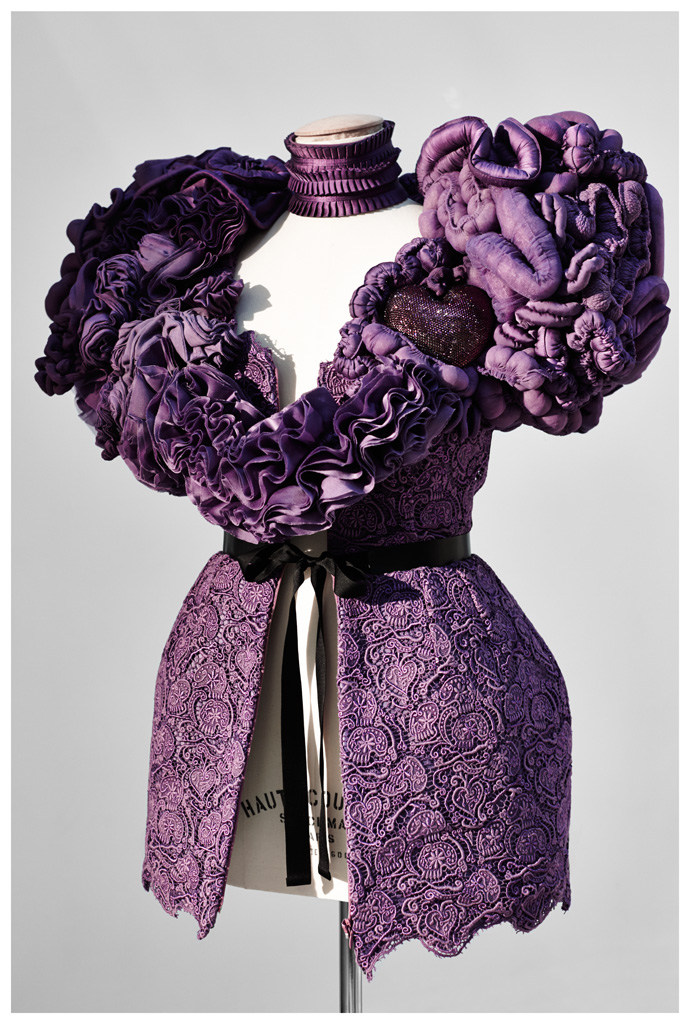
Inside out: Undercover dress with entrails, bone and skull lace, a heart on the right spot for the scary cute. Photo by René Habermacher.
The show at the intimate venue of the Institute Pasteur started with much delay, yet the undercover flock of disciples, among them the devoted Grace Coddington, awaited patiently what was to come from behind the antique glass-panelled doors: scary kittens with bunny masks on ponytailed shoes, wearing their insides out, ribcages and organs on outer display. Skeletal hands grasping waist lines, vintage lingerie elaborately piled-on to sleeveless evening jackets. Little dresses with what seemed to be ruffles at first glance, turned to be a romantic interpretation of entrails slung around the décolleté and a sparkling crystal studded heart.
Surprising,- or in the case of Jun Takahashi actually not- the arch from the drama of the unique pieces to the extremely wearable parts of the collection: googly eyes on a waxed trench coat, or the return of Undercover’s signature pieces, the perfecto, and the trench, with double collar and worn as a dress.
This is where the strength of Jun’s subversive vision lays: there is no friction between the everyday pieces and the elaborate constructed parts of his universe. Seamlessly he migrates between outfitter to the urban hipster to action art performer creating his giant Grace dolls from vintage plush toys in front of a bedazzled audience. The Graces, creatures from outer space were originally created for the presentation of the Undercover collection SS09 became somewhat of the labels mascot.
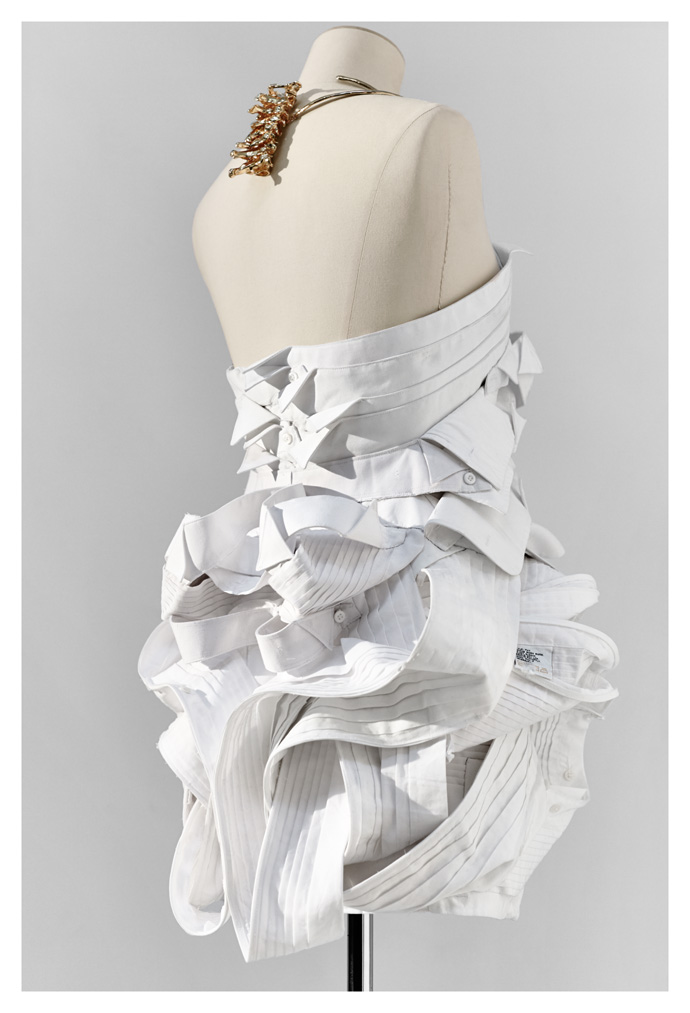
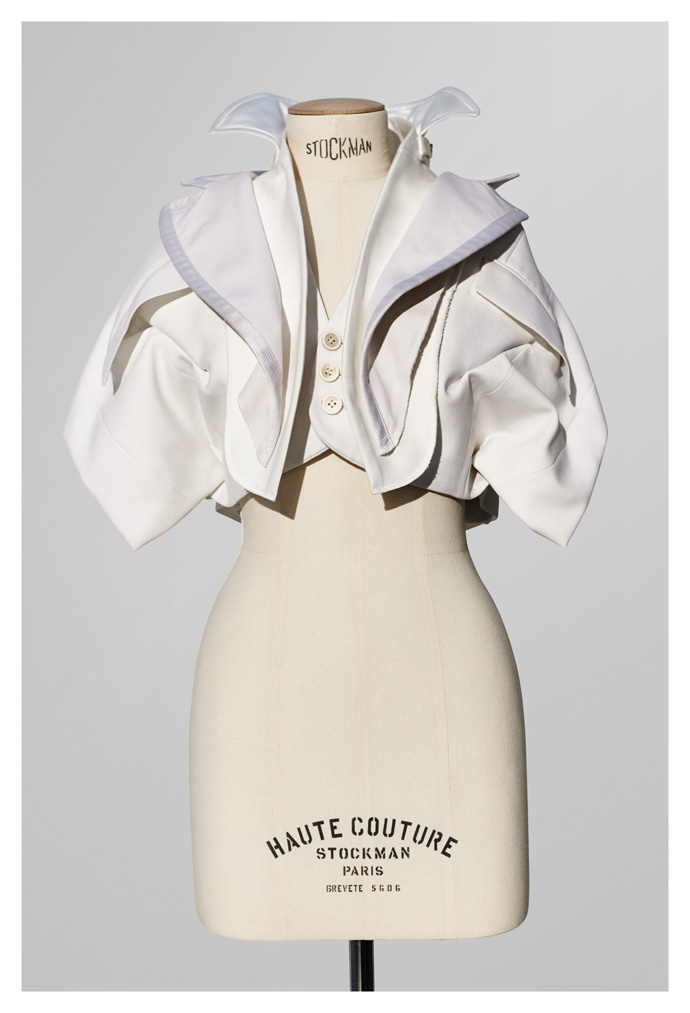
Starch undercover: special pieces made from deconstructed men's white shirt collars. Photo by René Habermacher.
René Habermacher: How is it to be back in Paris?
Jun Takahashi: It’s very exciting! Its been two years since we had the last show, so I am so happy!
You received well deserved great critics for this show of return.
how did you start with this collection, and how did it evolve and what is the narration?Last season when we came back to paris having just the showroom, I made seven special crafted pieces. It’s been a while since I’ve made such a creation and enjoyed it a lot.
It was just for the showroom, but this season i wanted to present a collection on the runway to show it to a broader audience. That’s how I started this collection.
The theme of the collection is about internal organs and bones, showing something from the inside exposed to the outside. Like lingerie that is usually hidden underneath, I used to make dresses and so expose them to the outside. That’s kind of the theme of the collection.Why did you decide at this moment to take the inside to outside?
I don’t know why (laughs). It’s been a while I wanted to show the “inside”. This is very undercover. It’s easy to express “Undercover”.
The motifs of organs and bones have something grotesque and scary in peoples minds. I take this and make it cute. It’s about both sides: not just scary, not just cute. we have both sides in the brand.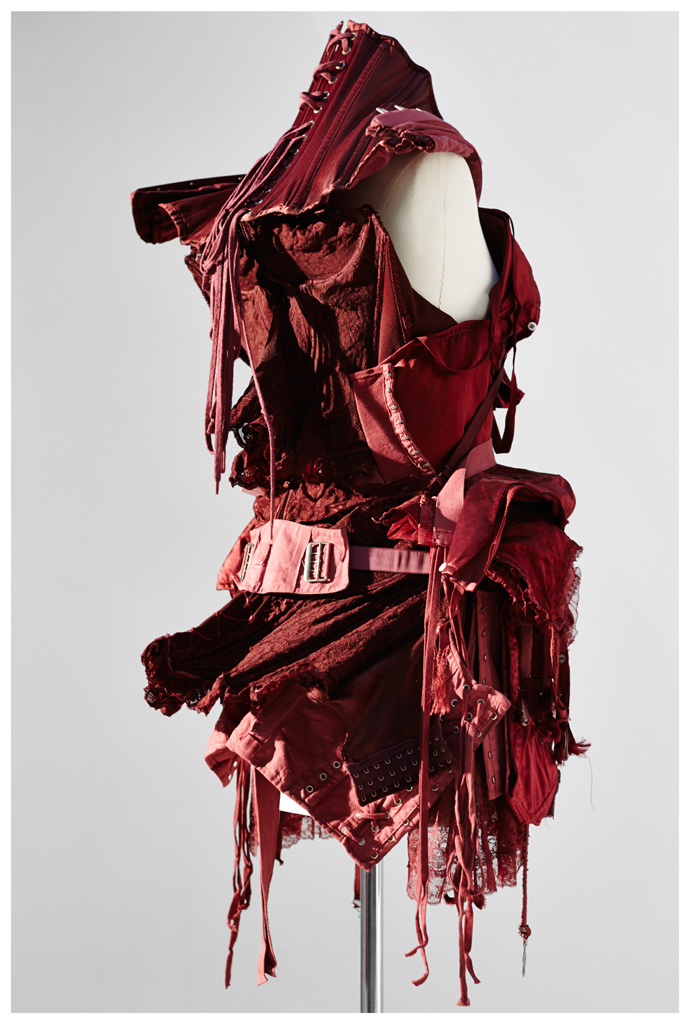
Pile-on vintage lingerie evening jacket. Photo by René Habermacher.
Are you a story teller?
(laughs) To me show is one big story, one drama, one stage. In a way I am not just making clothes, but one big tale, a story.
Since I was little I preferred the scary stories. I like Hitchcock movies. I am not necessarily into the ghostly but prefer the mental story.Another aspect is a strong sense of subculture evident in your work.
It is very different today then when you started off. What is subculture for you today?Most of he people surrounding me in Tokyo come from subculture, its a normal thing for me – its music, movies etc. not the mainstream. People in subculture are not specifically specialized in something – they don’t have mass-apeal. I like that. I source from this and then present my version in the “mass-area” like Paris.
Do you think exposure is dangerous for subculture?
The dark side of sub-culture! (laughs)
I take this positive. We always want to have information very quick- and I find this bloggers taking snapshots in the street very interesting, it’s really like I use the internet. How quick they are, it’s impossible for the print to catch up. Myself I like to post on Facebook and use the internet as a communication tool.Is the “season” still relevant to you?
When I design i don’t really think of the season. But when it comes to selling, we have to take this into consideration. For example in Japan we start selling FW collection in July, which is very difficult to sell Winter clothes because its still very hot for another 3 months until October. So we have to think about the balance between the creation and the business. So that’s difficult. We cannot completely ignore the seasons but not only thinking about seasons.
The runway shows’ timing are getting earlier and earlier and it takes time to actually get in the store.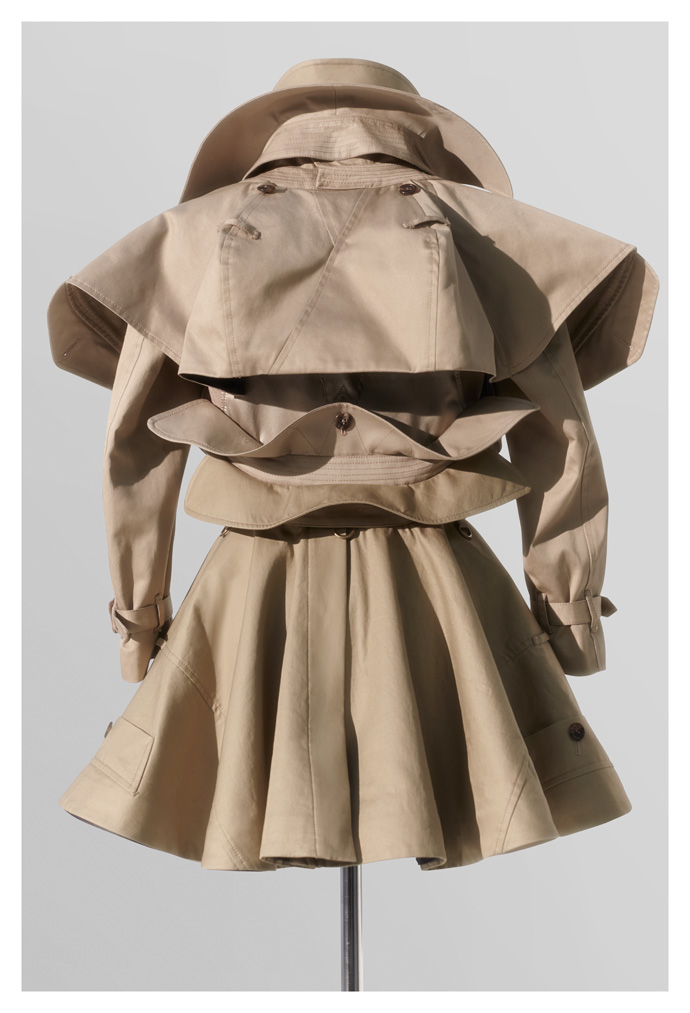
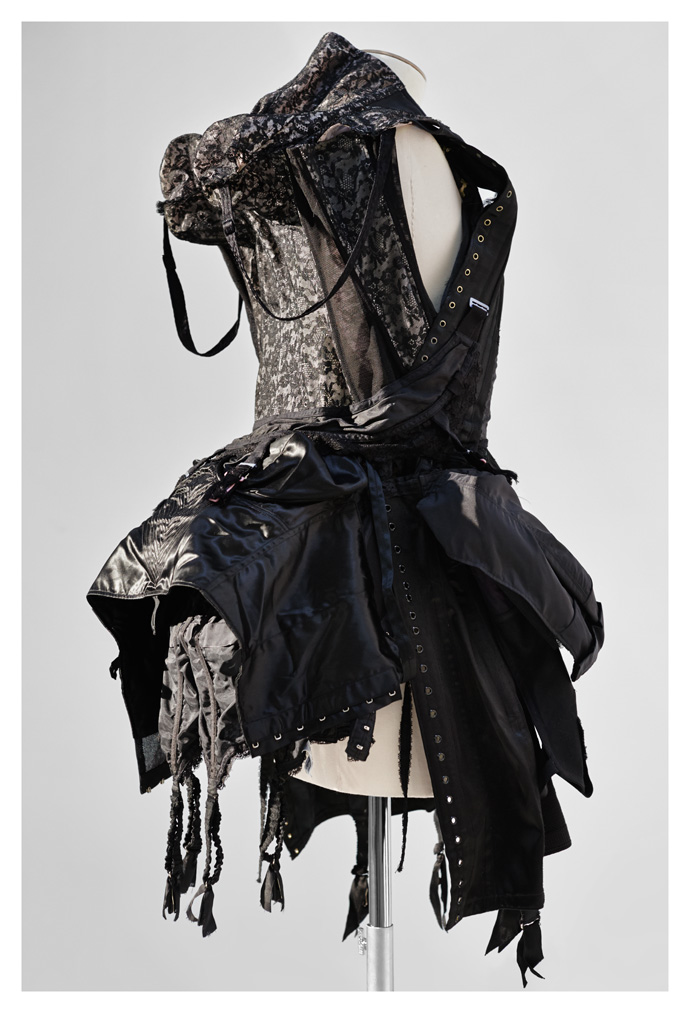
Undercover signature: the trench. Right: Pile-on vintage lingerie evening jacket. Photo by René Habermacher.
How is Japan to you today with the changes the country had been affected with the tsunami and the Fukushima incident especially?
Since the disaster was such a big thing and with the economical situation everybody’s feeling was like “hit the bottom.” We cannot be worse anymore. But now the people are actually trying to go up to be positive, they step back and reflect what can we do to recover from such a disaster. Maybe the government is not helping us that much, but people are trying to do something themselves, try to get the economy back and be positive.
How do you imagine the future your kids are growing up into?
They are little kids right now, but they are starting to have their own will where they wanna go. I am not so worried about them because they will find a way by themselves. We’re concerned about the future and the nuclear problem in fukushima, the earthquakes and what kind of effect this will have on us, but my kids will find their own way so I am not too much worried.
Are you still telling your kids stories of Grace? How is Grace, will we hear again from your creature?
I will continue with Grace- but Grace is not for little kids. They get a little scared… with one eye and all that.
I have a Grace doll in my house but at the beginning the kids were a little scared.But if you were a kid you would not be scared…
It’s scary – but there is an attraction too!
What’s next?
Showing the next collection in Paris again!
What is the last thing that stimulated you?
So many various things! conversations with friends – it’s not just one – it’s many different things.
I absorb everything. Family and friends are important. It’s important to have close friends that are straightforward in their opinion what they think about me, instead of just hiding things. It’s important to me to listen to them. A lot of my friends are creators, photographers doing their own thing. Their opinion is very important to me.
As I get older I get inspired and stimulated by more and more things. I can accept anything like a bus ticket.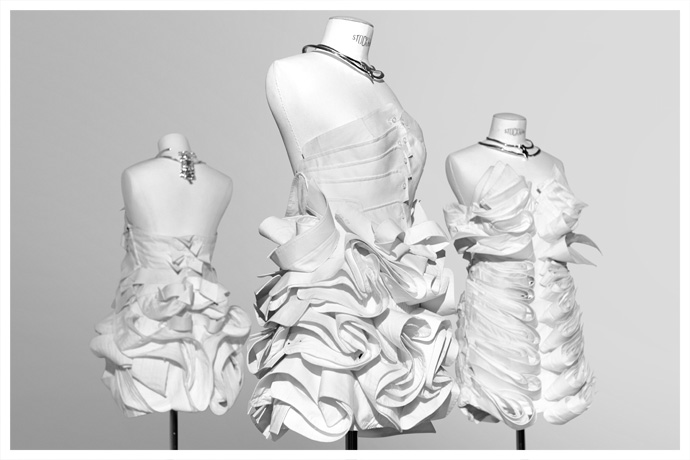
Trilogy in white starch: dresses from deconstructed men's white shirt collars. Photo by René Habermacher.
http://www.undercoverism.com
-

john lawrence sullivan : in the ring
-Tokyoite Arashi Yanagawa, the man behind menswear label John Lawrence Sullivan, has quickly become a fixture of the men’s fashion circuit.
The choice of name for the label is perhaps the most telling. John Lawrence Sullivan, the man, is a heavyweight boxing champion, also known as the “Boston strong boy,” and godfather of sorts to Arashi, who quit a promising boxing career to fight in another type of ring.
Ever since entering the seasonal arena of fashion week in Paris, he’s championed his collections in the eye of attention, with the likes of Suzy Menkes a constant follower. In this context, Arashi’s unconventional vision of the sharp tailored sportsman is most compelling.
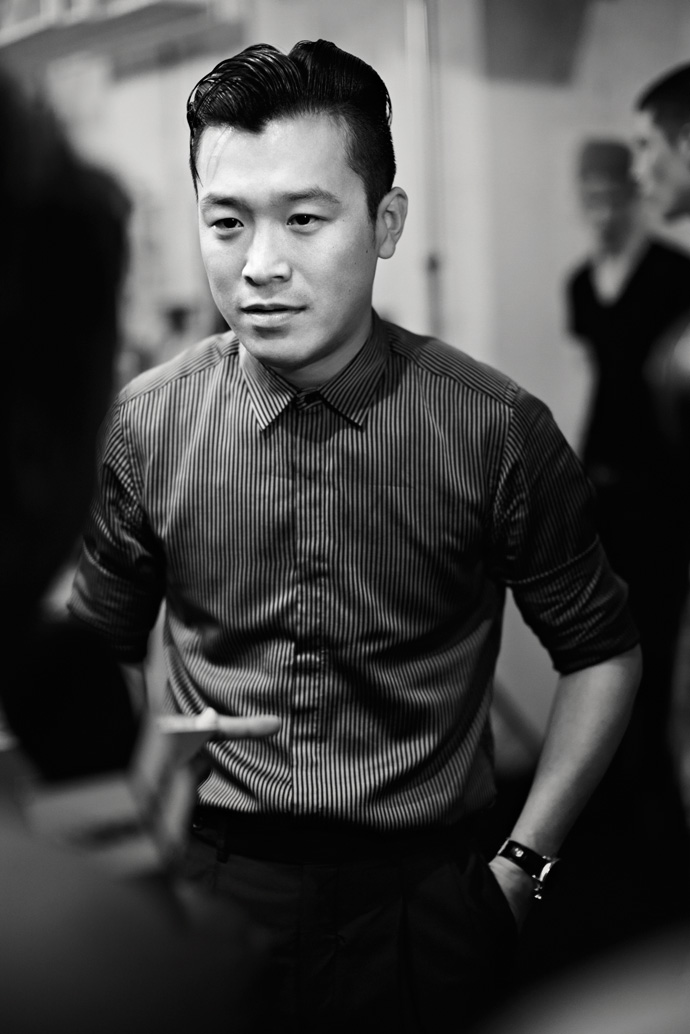 Arashi Yanagawa backstage after his John Lawrence Sullivan presentation. Photography by René Habermacher
Arashi Yanagawa backstage after his John Lawrence Sullivan presentation. Photography by René HabermacherRené Habermacher: Hello Arashi, how is it being back in Tokyo after your last show in the ring fight of Paris fashion week?
Arashi Yanagawa: I’m getting ready for the next match in June. While I’m always relaxed in the end, I also always begin thinking about the next collection right away. It’s exactly the same as in boxing.RH: In your work, specially your most recent collection, I sense a strong fascination with British culture.
but you’re successfully showing your 3rd collection, you chose Paris to present it…
AY: I believe Paris is the most important location for fashion in terms of the both the culture and the history of the industry. Paris has a special eye for beauty and elegance. No other place draws as many journalists, buyers, and fashionistas. All of this naturally makes Paris a very attractive city for presenters, but I also appreciate how strict everyone in Paris is towards creativity.RH: And what is it with you and London?
AY: London has street fashion just like Tokyo, but it also brings history and tradition into the mix. I’m impressed by the way all of this culture has just naturally rubbed off on the younger generations. Another example of something that has really moved me is the culture of the London market where you see young people today buying and even demanding clothing designed a century ago.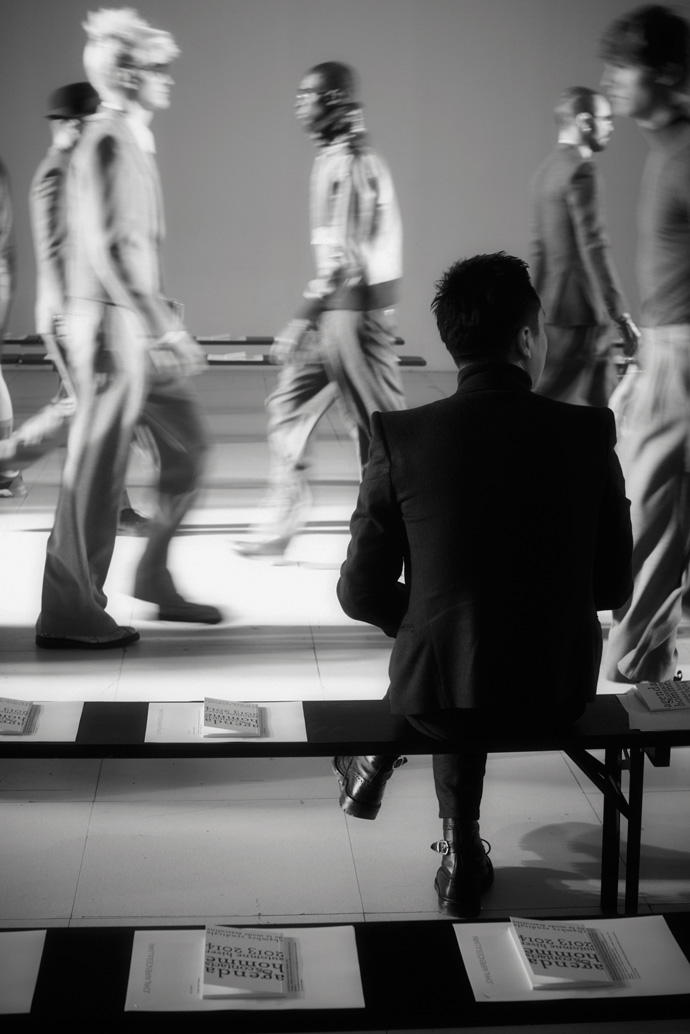
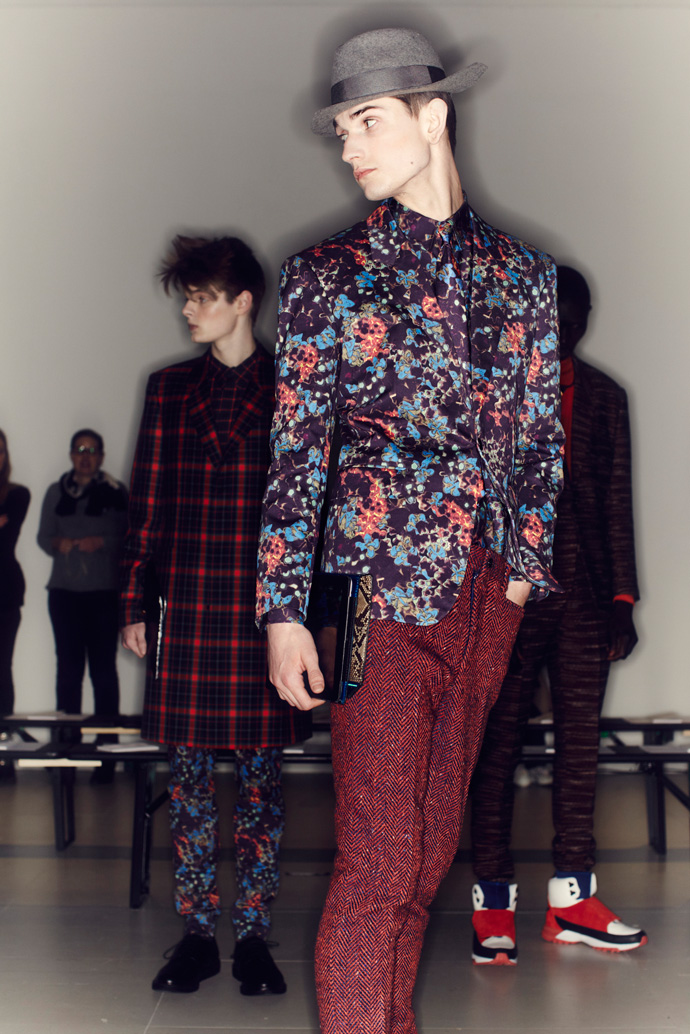 Rehearsals for John Lawrence Sullivan FW13. Photography by René Habermacher
Rehearsals for John Lawrence Sullivan FW13. Photography by René HabermacherRH: how do you decide for what you’ll go next? what is your creative process?
AY: I input the “sense” of the things I see or hear in my daily life and stockpile them. These could be colors, silhouettes, light, or even materials. But, I make an effort to express my own sense of the now rather than just making things based on historical research.RH: For the current summer collection the theme was influenced by the Bauhaus movement.
Why did you feel the urge for this now, and how did you translate that into the clothes?
AY: I had a chance to go to Berlin, so I paid a visit to the Bauhaus school in Dessau and took in the artwork there. I found the combinations of wood, leather, and metal used in the products there particularly interesting, and thought it might be fun to try doing the same things with apparel. So, I made the theme “Bauhaus” and began putting together the collection while referencing architectural cutting, artistic colors, and product techniques.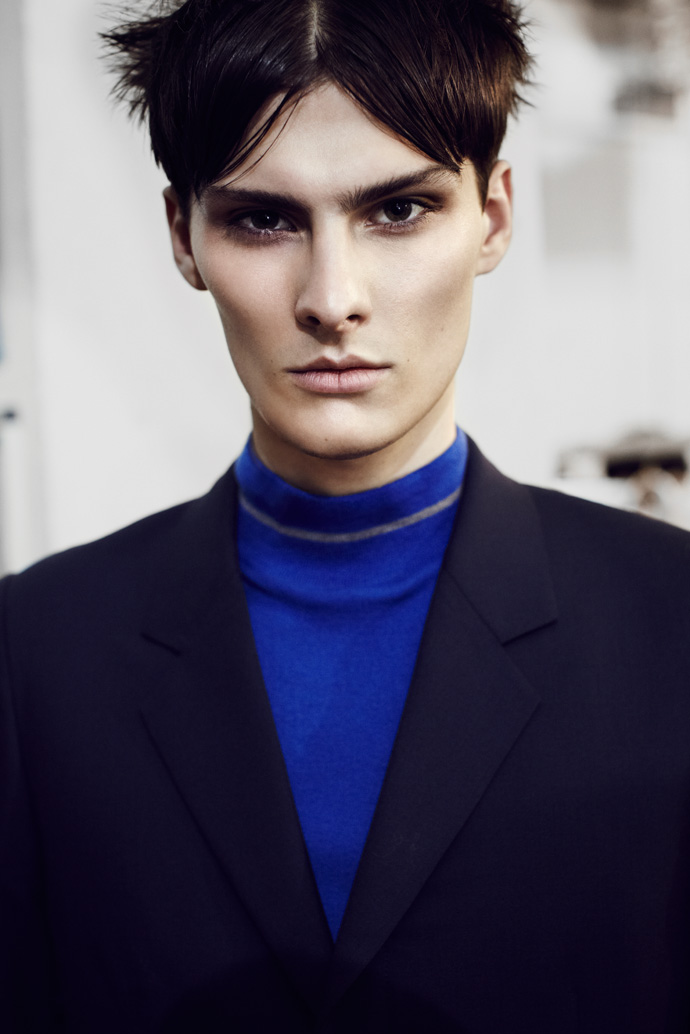
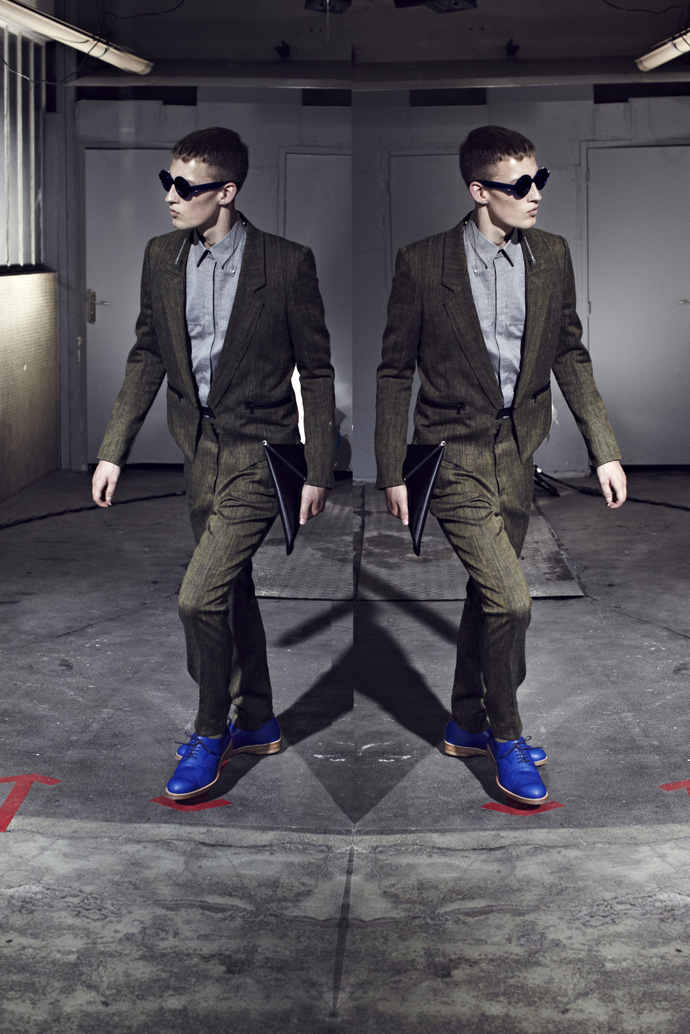 John Lawrence Sullivan's "Bauhaus" inspired collection, SS13. Photography by René Habermacher
John Lawrence Sullivan's "Bauhaus" inspired collection, SS13. Photography by René HabermacherRH: can you tell me more about “ELECTRIC AFRICA”: theme of the collection FW13/14, you just showed in Paris, what ideas are behind it?
AY: “Electric Africa” is a coined phrase. I had the idea to create a new, modern vision by combining tribal patterns associated directly with Africa with flashy colors instead of the standard earth tones. Tribal (triangular) elements were worked into various items and aspects like the cutting of the tailored jackets or the placement of the buttons. I also added a spacey essence reminiscent of the crop circles that suddenly appear in fields to the accessories, colors, and textures.RH: This collection also sports extraordinary footwear. Your sneakers have been hailed throughout. How did this design come together?
AY: I wanted create something akin to sneakers or trekking shoes, so I used Vibram soles. I also combined the base colors of the seasonwith highly contrasting hues in order to bring out a sense of Africa. I worked with a brand called ORPHIC when making the shoes.RH: Since you dropped your boxing for founding your label, fashion in Japan underwent quite some changes. How do you see the japanese approach today, what is your viewpoint and what influenced you over the course of time?
AY: When I started my brand in Tokyo my image was much more aggressive. I feel like back then many of the magazines adopted a fashionable approach, and that the buyers tried to answer the challenges the designers undertook with respect. But, as the economy got worse the magazines switched to much more easy to understand catalog-like appearance in order to make sales, which in turn influenced buyers, whose customers were influenced by this, to become much more conservative in their selections. So, there were a lot of negative things occurring in fashion here. The Tokyo runway shows were no different, as the focus shifted conspicuously to more “real” presentations rather shows with a bit a fantasy or elegance to them. Feeling all of this made me want to do my shows somewhere more stimulating, so I chose Paris.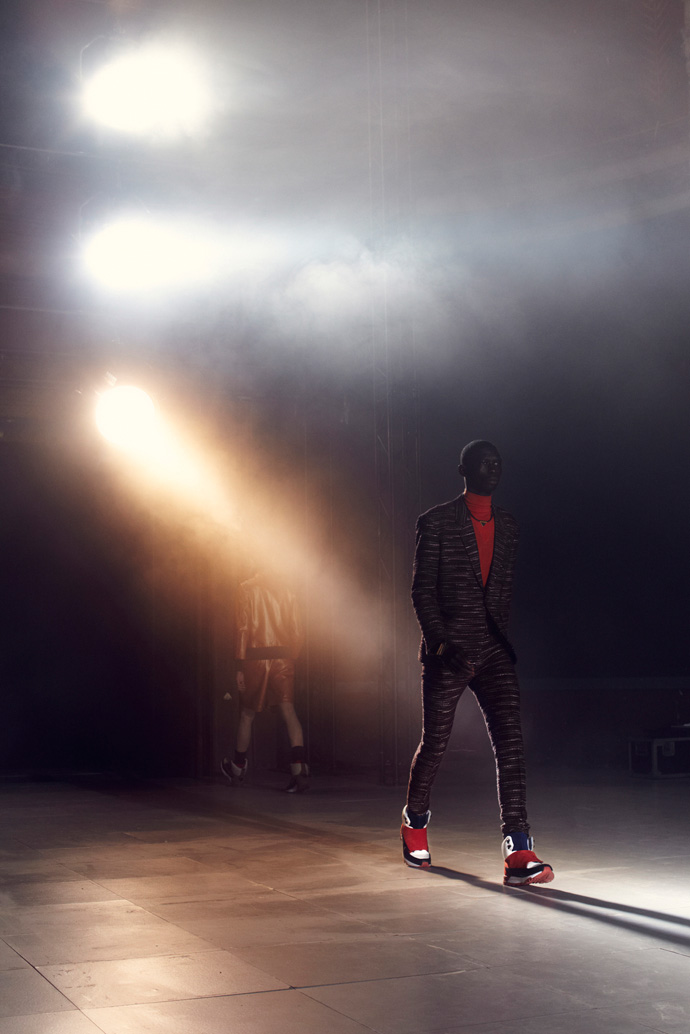
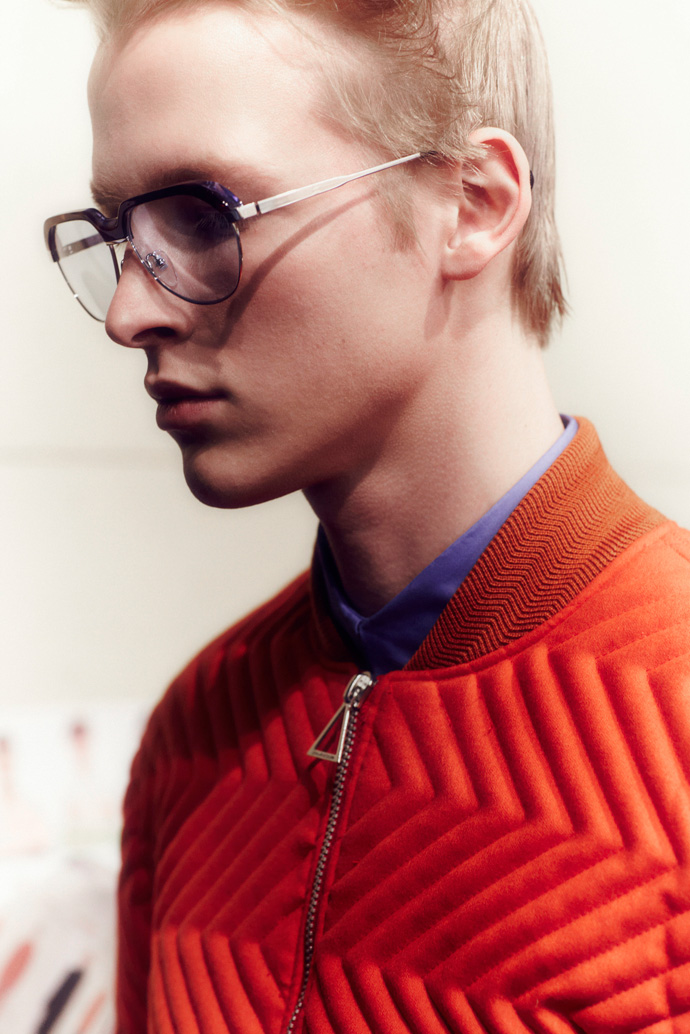 "Electric Africa", John Lawrence Sullivan FW13. Photography by René Habermacher
"Electric Africa", John Lawrence Sullivan FW13. Photography by René HabermacherRH: While developing your collection, are you having a specific type of man in the back of your head?
AY: I always imagine a man who possesses both beauty and strength in terms of appearance and mind. If I were to provide a sportsman as an example, there is a certain boxer who comes to mind…RH: Are there any parallels you can draw between your sports career and the one in fashion?
AY: One thing I realized when I first started working in fashion is that there is a common trait shared by boxing matches and fashion shows that only I seemed to notice. This was the way in which you worry over something that will last only few minutes on a single day for months in advance, battling with your anxieties and, as long as you don’t give up, preparing for the next match as soon as it’s all over regardless of whether you won or lost. The way everything seems so fleeting and transient once it’s all said and done is also the same.RH: The understanding of classic tailoring is a very strong element in your work. Now you started your women’s line: how does this apply here?
AY: Incorporating classic tailoring into women’s fashion is one of the most important elements for John Lawrence Sullivan. This isn’t something just any brand can do, so it’s something we will continue to actively working with in the future. One of the differences between men’s and women’s fashion for me was the way in which things like esthetic elements concealing points I had complexes about confused me a bit at first. Now I feel that I have learned to use men’s techniques to deal with these things.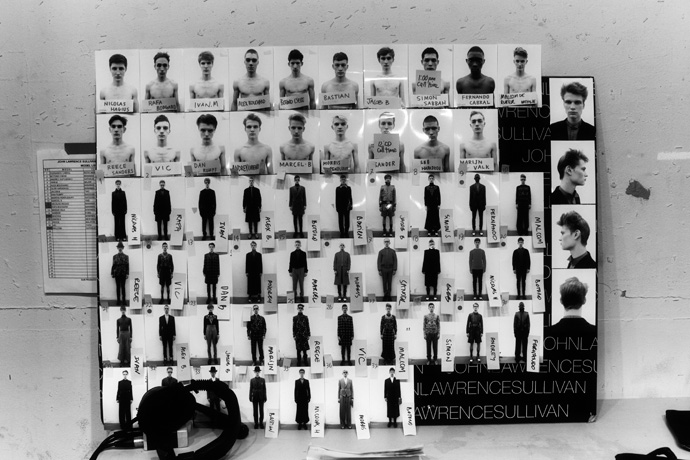 Showboard with looks and cast for "Electric Africa". Photography by René Habermacher
Showboard with looks and cast for "Electric Africa". Photography by René HabermacherRH: As you added another collection to your house – your work wheel must spin faster evidently, with 4 instead of 2 presentations.
AY: I always think of how I can break down the restrictions of the tailored look when I do my men’s designs. While there is the sense that I can be confident in breaking these restrictions down precisely because they exist, but with women’s my process is one of imposing my own restrictions on the things I design freely. So, there is a sense of mutual stimulation between my men’s and women’s lines that has been a good influence in my opinion. That said, I am definitely much busier than before…RH: Do you feel urged by the increasing numbers of pre-collections and cruise collections that the big houses lately launch?
AY: This is most likely just a sign of the conservative sales trends we’re seeing worldwide right now.The big houses are just doing this as a way of making sure they continue to pull in revenue. I too feel that JLS must do the same if we are to continue showing in Paris, so I’ll be considering various strategies for this in the days to come.RH: With clients all over the globe in different climate zones: do “season oriented” collections make still sense to you? (already the weather in Japan is quite different to the north american or european)
AY: Breaking things up by season allows designers to change up their mood and add depth to the presentation, so I most definitely think it has meaning. But, I also feel that in terms of actual sales it is often seasonless items that perform the best.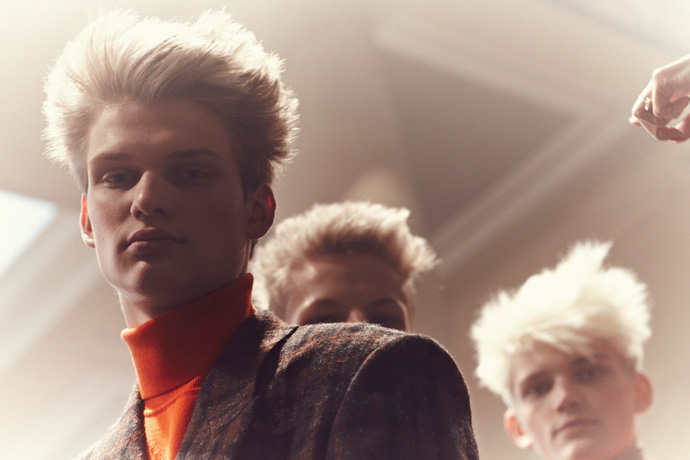 "Electric Africa", John Lawrence Sullivan FW13. Photography by René Habermacher
"Electric Africa", John Lawrence Sullivan FW13. Photography by René HabermacherRH: How do you perceive the present of fashion?
AY: I think what we are seeing is a mixture of various styles coming together.
This is also exactly why I feel that you can’t make it in this day and age unless you believe in yourself and keep making bold presentations. I guess you could say I feel we’re in an era where only the essentials survive. I want JLS to continue to be a brand that always takes up the challenge of presenting in Paris.RH: What is up next?
AY: The designs for my women’s exhibition in March and preparations for the 2014 S/S season.RH: What is the last thing you saw, read, heard or felt that stimulated you?
AY: Tadao Ando, James Turrell, Donald Judd, Taro Okamoto, Talking Heads, Pixies, David Bowie, Wes Anderson, Jim Jarmusch, Kinji FukasakuWebsite: John Lawrence Sullivan
-

this hyères : full circle
-Full circle.
For its 28th edition, the Hyères International Fashion & Photography Festival made a daring choice.As presidents of the fashion and photo juries and guests of honor, they invited 2 young individuals, each recognized in his field, but with one thing in common: they won Hyères.
Yes, this Hyères, festival graduates Felipe Oliveira Baptista (2002) and Charles Fréger (2001) return, not as young hopeful nominees, but as still-young confirmed professionals, now presiding over the juries.
Hyères 2013 fashion jury president Felipe Oliveira Baptista. Photo by René Habermacher.
Hyères 2013 preview. Visual by The Stimuleye.
And the nominees are…
FASHION SELECTION
Tomas Berzins & Victoria Feldman, Latvia + Russia
Henning Jurke, Germany
Camille Kunz, Switzerland
Yvonne Poei-Yie Kwok, The Netherlands
Xénia Lucie Laffely, France – Switzerland
Satu Maaranen, Finland
Marion de Raucourt, France
Damien Ravn, Norway
Shanshan Ruan, China
Xing Su, CanadaPHOTO SELECTION
Lena Amuat & Zoë Meyer, Switzerland
Emile Barret, France
Petros Efstathiadis, Greece
David Favrod, Switzerland
Dominic Hawgood, United Kingdom
Grace Kim, USA
John Mann, USA
Anna Orlowska, Poland
Peter Puklus, Hungary
Eva Stenram, Sweden Fitting Model at the fashionselection at Felipe Oliveira Baptista's headquarters.
Fitting Model at the fashionselection at Felipe Oliveira Baptista's headquarters.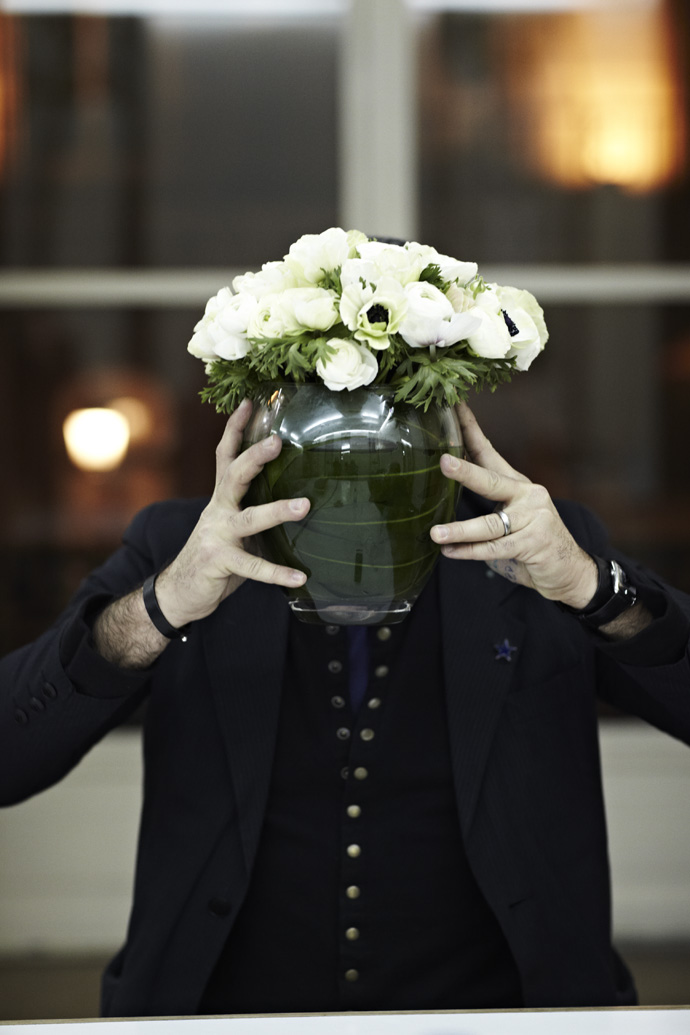 Where is JP Blanc there are always flowers.
Where is JP Blanc there are always flowers.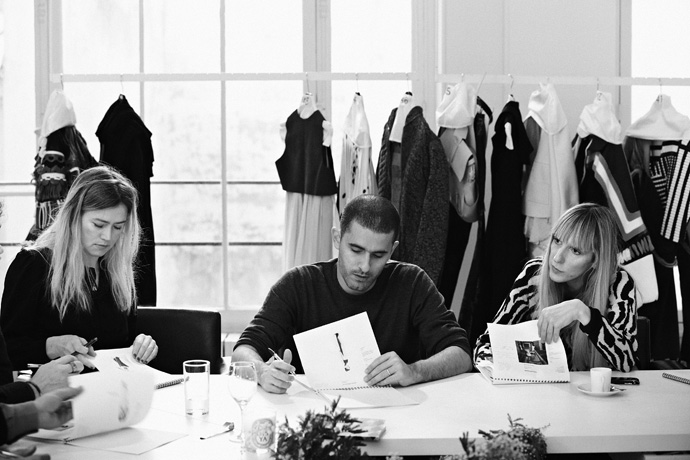 The fashion selection meeting, with jury members, festival director JP Blanc and blogger Filep Motwary.
The fashion selection meeting, with jury members, festival director JP Blanc and blogger Filep Motwary.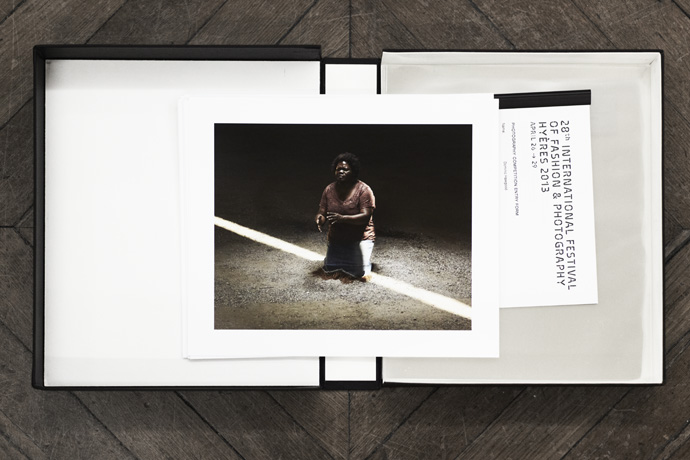 Photography selection: Portfolio of Dominic Hawgood, United Kingdom.
Photography selection: Portfolio of Dominic Hawgood, United Kingdom.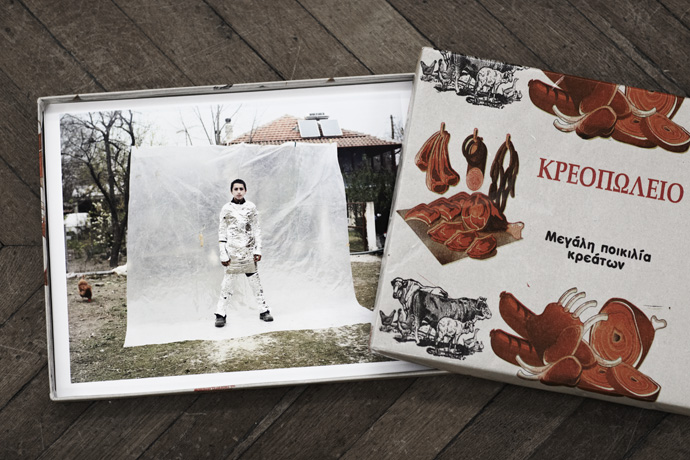 The entry of Petros Efstathiadis, Greece.
The entry of Petros Efstathiadis, Greece.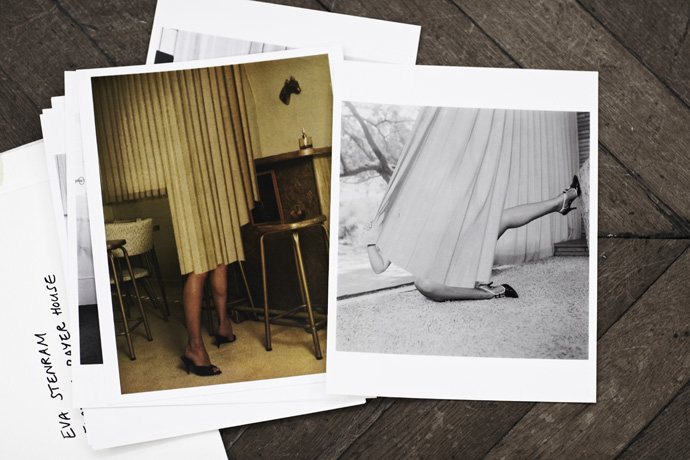 Prints of Eva Stenram, Sweden.
Prints of Eva Stenram, Sweden.Full jury and exhibit lists coming soon, but we’re happy to report that fashion photographer and film maker Pierre Debusschere will be among this year’s exhibitors.
28th International Fashion & Photography Festival
Hyères 2013, April 25 -> 29
at Villa Noailles, Hyères -

MONSIEUR HERVÉ
-What’s in a name ?
You can ask Kenzo Takada, Martin Margiela, John Galliano, Valentino Garavani or Helmut Lang – designers who, for various reasons, left the company which bears their name, and then had to make themselves a new name, in fashion or elsewhere.
Or you can ask Monsieur Hervé Léger, the legendary French designer who took fashion by storm with his body-conscious designs, ultimately embodied by the “bandage” dresses. Monsieur Hervé Léger does not design for Hervé Léger, the company. Monsieur Hervé Léger designs for Hervé L.Leroux, a nom de mode suggested by Karl Lagerfeld.

Photography by René Habermacher
Filep Motwary, who met Monsieur Hervé through model and muse Suzanne Von Aichinger, talked with the designer as he prepared his new couture collection for Summer 2013, now on display in Paris in Colette and on presentation in Monsieur Léger’s new but history-laden atelier.
Filep Motwary: So, how is your day so far?
Mr. Hervé Léger: Well it’s cool. I am peaceful today. Yesterday I was not, but today I am.F.M: You are getting ready for your Couture collection ?
Mr.HL: Yes, you see I am a professional, I try to do everything in the right context and I do not like to keep my people working at night and we are trying to be efficient and of course we will be ready on time. You know I’ve been creating for a long time, but because I didn’t want to make shows, my comeback is under new conditions. And it figures that some people always followed me and now I sell worldwide. Business is good now finally again and I am pleased.(As we speak, Suzanne Von Aichinger and René Habermacher are working in the showroom photographing the garments),
F.M: I understand. Do you mind if you help me fill some gaps of your life’s storyline, because it’s out there, but not fully completed… So, it was during the late 1970’s that you started-off your career as a hat maker and hairdresser?
Mr.HL: (Laughs) It’s a crazy story, but… I’ll try to make it short. I had done some studies like everyone, I went as a young man to the Beaux Arts in France though I only stayed for one year as it was the 70’s and France was all about manifestations at the time and intense political changes. As students, we were on the streets demonstrating and I wasn’t learning a lot since everything was on strike.
I also wanted to be independent from my parents and wanted to do something by myself, to work. I am very good with my hands; I am a craftsman and can do everything with them in terms of creation so I decided to be a hairdresser. Although I didn’t study hair, I learnt the job very quickly by opening the door of a hair-salon telling them I wanted to learn. They took me and stayed there for a while. Then I started to make hats, after finding a book at my grandmother’s house, which was full of illustrations on how to make them. The first customers arrived and I was working at home. So there goes the “hat story”.
Then one day someone who was famous in the 1970’s asked me to do a very particular hat, a-giant-sort of “Belle Époque” hat with a lobster on it (laughs). The guy’s name was Tan Guidicelli, whom you probably might know. It wasn’t long enough until he asked me to make three dresses for his show because his atelier was very busy and his show was in three days. Although I had never designed any dresses before, I said “Ok, I’ll do them” and when he saw them he said “ you got a real sense of fashion and you should stop hairdressing and come work with me”. So that was my first fashion encounter.
Of course I dropped hairdressing and started to learn sewing. Later I went into design. My second big encounter was Karl Lagerfeld.
The 1980’s were an easy time. You could easily meet someone. People were more open. Even during my days as a hairdresser, with my friends, you could end up having dinner with Claude Montana, Mugler, Lagerfeld etc. It was not such a big deal as it is today. It was proper dinners you know, not charities. So at the time I met Karl at the house of a journalist friend and something happened immediately. We started talking about corsets (at the time I was fascinated by corsets). So that was on Saturday and on Monday my friend from “Woman’s Wear Daily” called to say “Karl wants to see you.” So I went with a few sketches and he said, “ Well, I don’t care about your sketches, I’m looking for an assistant at Fendi in Rome” and I said “Yes!”.
So by next Friday I was on the plane flying to Italy.Then I went to Chanel for one year and worked for him until I was fired.
I created my own label in 1985 but the bandage dresses came out only in early 1990’s. I don’t consider the beginning of my career started in the 80’s. My career, as I see it started in the 90’s.F.M: Tell me about the bandage dress…
Mr.HL: The real story of the bandage dress is important as a fact of my work storyline. I was having a show at Angelina Tea Salon in Paris, and I wanted something glamorous for the finale. I didn’t have the fabrics. A few days later, I went to a factory and found some bands of metallic yarn, sort of lurex. I asked, “What is this?” and I was told “its for the garbage”. So I took that and I started to put one yarn next to the other and started molding the bands on the dummy, exactly like you do hats. And that’s how the first bandage dress was born. I did the show and it was a success.
I was hooked on these new for me materials and started to experiment. In the beginning, I did not want to put any zippers because I wanted to create a dress with no seams. The problem was that I did make the dress with no seams but when one of my clients got herself in, she couldn’t get out (Laughs).
Then came the presentation of nine dresses in the office of my press attaché at the time. The fashion journalists from American Elle made pictures and became a success very quickly.
F.M: This technique you are working on, the way you make your garments is really one of its kind. Allow me to say that I see them as dresses for women to please men…
Mr.HL: It’s true! Its because they make women look great. The fit is great because it shapes the body. For example, the body of a young girl is not my cup of tea. I like bodies with a bosom, with a waist, curves…
My dresses can give a shape even to bodies that are not perfect. This is why I think men love them the same that women who wear them. They seem almost like a modern corset with no bones. The fit that a woman experiences at Herve L.Leroux is the fit I invented at Hervé Leger. Even in my couture dresses today, I use the bands and my own technique, the one I invented then.
F.M: Hervé, I want to ask you about the true story about what happened. How did you lose control of Hervé Léger in 1999.
Mr.HL: People say that I sold it. That’s a lie, I mean I wish I would have sold it.When the bandage dresses started to be famous, a man that was fascinated by them approached me. He said to me “I went to a party in Caracas and a woman arrived in one of your dresses and everybody went crazy.” He “chased” and sent me some bankers asking to be my partner. Of course I said “Yes” because I wanted to develop this business and I didn’t have to run after any partner anymore…
It was a nice combination and it was Seagram, a very powerful group who invested money and soon Hervé Léger became a major house.
Though I had to be very conscious about the number of sales, otherwise they would drop me. The story is that the guy from Seagram decided to get rid of a few companies they had in order to invest on a bigger French company called Vivendi. At the end he sold everything, including me, although he assured me before that he would find me a new partner and he would help to finance the changes.I had someone who wanted to buy the company from Seagram, they put the dossier in the bank’s hands and then they sold it to Max Azria. So he bought it, though I tried to make it work but it fact it didn’t. At the time I was only left with 5% of the company…
When people invest in a company, especially in the fashion industry, the designer or the name behind the company, has to stay part of it otherwise it won’t invest.Some people like Donna Karan, did it in a very clever way for example.
I guess it didn’t work for me because I didn’t have good lawyers at the time…I didn’t agree with the strategy and they fired me from the house I had created. The worst of it all was that he didn’t know what to do with the house of Léger for a long time. In 2007, which is quite recent I may say, at the same moment when I decided to do ready-to-wear again, he opened the archives he started to re-do my dresses from back then for Hollywood stars and the bandage dresses were successful again.
F.M: And what did you do?
Mr.HL: Wolford contacted me and they asked me to work for them… Then came my shop. The problem was I couldn’t use my name anymore. It’s Karl Lagerfeld who came up with the idea of Hervé Leroux. He said “you’ve got red hair” so it has to be called Hervé Leroux and put the “L.” in the middle, who knows one day you can do again “Hervé Léger Leroux.”F.M: So, back to your collection. How did you start again?
Mr.HL: In 2000 I did a comeback with ready-to-wear and I had immediately lots of customers coming, especially from America. Then came another incident, 9/11. No one came after that.It affected everyone and the business went downhill. That’s when I decided to stop ready-to-wear as it was very expensive to create, have production control, distribution etc… So since then, I focused on Couture until 2007, only for private customers and some shops that wanted to buy a few of my pieces. It was a difficult time but I survived.
It was in 2007 when my customers wanted my ready-to-wear again and it went very good. We are in Colette and so many other prestigious boutiques around the world now. I am very satisfied.
F.M: You are a designer that works with couture methods, a real artisan. How do you see the use of “future” references and approach in fashion in combination with technology?
Mr.HL: I think moving towards the future is good for this business, generally speaking..Sewing a dress is always sewing a dress.
For me what is more important is that the clothes look good and made with good materials. I know nothing about technology whatsoever. I know that my clothes are very true; I use very particular techniques to make them. I am more of a couturier rather than a stylist. I don’t go scouting for old clothes to re-do them, I don’t search for ideas around. Even at moments when I wanted to copy someone, I just couldn’t do it you know?Other’s people’s clothes don’t inspire me. I am obsessed by my own ways of creation and I feel lucky to have customers starting from 16 to 70. I am never about trends; I see no use in them. Today I have the feeling that it is all about money. Designers today don’t spend hours fitting a dress on a body. They do it on dummies. I feel comfortable with the way I work.
F.M: How were the 1980’s and 1990’s fashion scene compared to what we see today?
Mr.HL: Oh my God, things were so happy back then, so happy. The 70’s, the 80’s and the 90’s. People were passionate and they could make money from that passion. Bankers, investors or whatever you call them didn’t really exist then so designers were freer. Only one thing Filep, the aesthetic of the girls then is what is missing from today.Or the power the shows had back then. Think of Montana and Mugler!! Oh my God, the girls were so beautiful, the way they walked. I feel lucky for living through that era working with all of them; from Linda to Cindy… I had them all.
And they were so full compared to today that everyone is so skinny. And all my models loved the clothes; you know a lot of clothes would disappear after the show (laughs). Even during fittings those girls would feel the clothes, they were posing.
Today my favorite show is Victoria’s Secret because it’s a happy one. I am not saying girls are not beautiful today, I just think shows today have become boring and less inspiring. They look like robots and there is no charm. I really wonder if I was to do a show today how I should do it and not look ridiculous and dated.
And sometimes I speak with journalists and they are bored of the current situation too.
Anyway, I am not ready to do a show now also because I am not a kid. If I do a show it has to be made the right way as a good show also costs a lot of money.F.M: Maybe you could do a little show in a Hotel Suite like couturiers used to do back in the 50’s.
Mr.HL: Hmm, yes. For this season I just wanted to show the work the way it is. Starting on Monday, Colette will have 5 of my dresses in the window and on Thursday I am showing another 12 pieces in my showroom as I have been invited by the Chamber of Haute Couture and it feels wonderful.F.M: What is this collection about?
Mr.HL: You know I never start saying “I’m going to do this and that”. I just grab my fabric and start working. All I can say is that 80% of the collection is done and it looks like a walk in a Japanese garden. The drapes are very graphic in the sense of Japanese design…F.M: Why does couture still breath? Is it merely a question of tradition? Why does it still interest people?
Mr.HL: It’s exceptional I would say with an excellence. Although the world has changed and we are in the middle of a crisis, luxury is always surviving. What is luxury about today is another story than what it used to be. There are a lot of luxury houses that produce clothes or bags in Taiwan etc. but, there are still women who want to dream. I see my clients… And the movie stars I dress – of course they don’t buy the clothes (laughs).There are still women who are not in the spotlight, not in the newspapers yet they prefer couture because it is special. They are in search of the perfect fit and for me the fit is something important.
F.M: Why is couture so personal as it requires the customer and the designer in a very private session?
Mr.HL: There are less and less couture houses as time goes by. Chanel is a real Couture house for example because they have the right hands to do the artisanship, Gaultier also as well as Dior. Couture has a certain way of doing it, it has its own rules, and also the fabrics are richer. Everything is on made on perfect scale. There are more and more rich people and the opposite, which I find very depressing. We can say there are people who are rich today and they are richer than what the term “rich” meant 20 years ago..
Those who spend, really spend…F.M: What provokes the strongest emotions in you nowadays, compared to what made you emotional in the past?
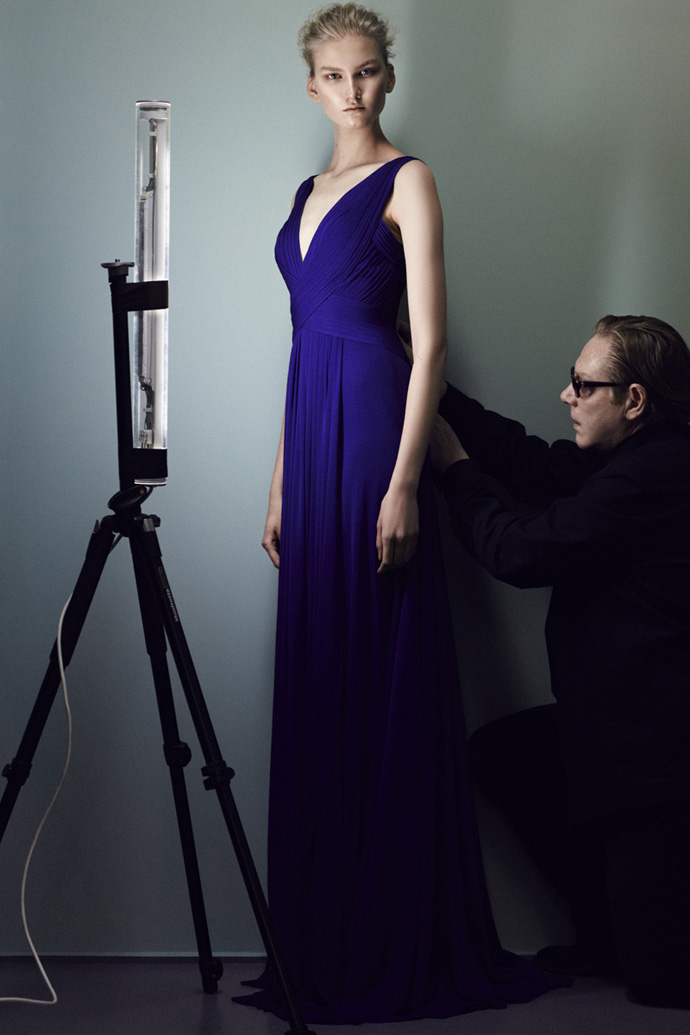
Mr.HL: When I was “Hervé Léger” I was never satisfied. Nothing was good enough and I always thought I could do better. Today, although I still want to do better I become emotional by looking at my own dresses, a feeling I never had before.
I am happier today because I don’t have anybody else involved in my business; I have a great team of loyal people working with me. Also what is very emotional for me is when I see women trying my clothes on.F.M: What is next for you?
Mr.HL: I’m working on developing my business. A perfume that I am working on. I want to start doing accessories, shoes, lingerie and swimsuits. Also my customers locked me in my atelier designing dresses – at least I am famous for something (laughs)- but you know I am very good in designing suits, coats, pants and blouses…Basically when you are wearing Herve L.Leroux, is for the evening. I want to make day-wear too. Although every time I do they never buy it, but I’m going to push.
The interview is a collaboration project between Un nouVeau iDEAL and The Stimuleye.
interview FILEP MOTWARY
photography RENE HABERMACHER
fashion editor SUZANNE VON AICHINGER
hair PANOS PAPANDRIANOS
make up YIANNIS SISKOS
model ANNA MARTYNOVA@ NEXT MODELSthank you VERSAE VANNI @ NEXT PARIS
-

Olivier Saillard, Violetta Sanchez, and 25 ways to be a turncoat
-“We nominate McQueen at Mugler and Armani Casa at Margiela…
We nominate Margiela at Schiaparelli and order him not to make any collections to preserve the surrealist spirit of the house.”

Curator Olivier Saillard hosted another one of his legend-in-the-making performances during couture week, this time in the intimate setting of the APC headquarters.
For 30 minutes, Saillard and his collaborator Violetta Sanchez pushed the classic man’s grey blazer to the limit (and beyond) by showing 25 ways it could be worn, while reciting a surreal list of nominations that read like a “who’s who” and a “what’s-wrong” with today’s fashion scene.
Can’t wait to see what Saillard comes up with next.
-

hanaa
-It’s not everyday that an Arab woman is chosen by a major cosmetics brand as its global spokesperson…
The Stimuleye presents “Hanaa”, a film by Antoine Asseraf & René Habermacher, starring Tunisian model Hanaa Ben Abdesslem, spokesperson for Lancôme.
Antoine Asseraf: Where are you from, and how were you discovered ?
Hanaa Ben Abdesslem: I was raised in a town on the sea coast of Tunisia named Nabeul.
I dreamed of becoming a model since I was very young.In 2009, I participated in a reality TV show for models in Lebanon. There I met Sophie GalaI, who would become my manager, and in 2010 she presented me to IMG Paris, who in turn presented me to Carine Roitfeld, at the time Editor-in-Chief of Vogue Paris.
Through her introduction to Ricardo Tisci , I was chosen as a Givenchy fashion show exclusive that same season.
AA: You’re becoming an icon representing the “middle-eastern woman” in the fashion world and beyond,
but which people are icons to you ? Can you tell us a bit about your relationship with Farida Khelfa ?My icons are the Tunisian women in the fashion industry, whom I admire and whose accomplishments I respect, such as Liela Menshari, Hermes window designer — she received the Golden Dido Award for her contribution to Tunisian culture and influences in world, and Afef Jenifen, who fought for Arab women’s freedom of choice and continues to defend their rights.
Farida is a great support and she always has good advice, such as “stay true to yourself.”
HANAA
a film by Antoine Asseraf & René Habermacher
starring Hanaa Ben Abdesslem
styling Yoko Miyake
hair Nicolas Eldin
make up Tracey Gray Mann
production by Clast
postproduction by The Stimuleye
text by Omar Khayyam
sound by Gnawa Diffusion
thanks Sophie GallalLook 1: Dolce & Gabbana
Look 2: Jil Sander by Raf Simons
Look 3: Chloé
Look 4: Stella McCartney -

the museum of everything
-Art. What is it ? Where does it start, and where does it end ?
In today’s contemporary art “market”, it seems no one bothers asking the question anymore.
Art, as it would appear, is whatever is made by a self-claimed artist, whatever is recognized by the market.Enter The Museum of Everything.
Premiering in Paris at the new Saint-Germain location Chalet Society after several exhibits in London, this groundbreaking, sprawling, multi-level and multi-layered show changes the game.Forget the market.
For founder James Brett, it’s about special things, made by special people, people who haven’t gone to art school or thought of showing their work, much less of selling it.Antoine Asseraf: What started you on The Museum of Everything project ?
James Brett: I don’t come from a particularly artistic family and my parents never taught me what creativity meant – but as a child I had a lot of it and it always got in the way.And so I worked in different industries and was working in film, and I remember meeting a very interesting photographer, the late Bob Richardson. He was the father of Terry Richardson. Terry’s a terrible photographer (sorry!) but Bob was a genius. He was the first person who really told me that “You don’t choose it, it chooses you”.
In the same way, I can’t really tell you why I started The Museum of Everything. I didn’t set out to do it, I wasn’t interested in art, exhibitions, nothing. But I was working in film and I know film very well, I studied acting, so I’m creatively interested. And in my travels I started to see artworks, first of all by people in the American South, that was just cool and graphic. I always liked graphic novel and comics as a child – and as an adult frankly – and they started speaking to me.
The artworks were cheap, really like 20-25 bucks, and the more I looked the more I found. I started finding better examples, and realized there was a whole history in America of folk art, African-American art and self-taught art which seemed to come from the individual, it didn’t have the pretension or the words of formally-trained artists, and it was immediate. As a film-maker I loved that, because I’m not really interested in what you are or what you say, I’m interested in the stuff, in what you do.
As I continued I saw there were some other areas that had a great psychological depth. For example, the work of Henry Darger. I discovered there was a word for it, Art Brut, of which Dubuffet was the proponent. And that also interested me because in my youth, I was fascinated by the mind, how the mind works, and why we make the choices we do, all of this sort of existential philosophy of life.
Prophet Royal Robertson untitled (NO DIVORCE WHORE's ALLOWED), c 1980 © The Museum of Everything
-

jean paul lespagnard: from b to a
-B is Belgium.
A is Africa.
Leave it to Jean Paul Lespagnard to connect the 2 in a fresh way for his SS2013 collection.
You can also see one of the key outfits from the collection in action, as worn by Lynsey Peisinger, in the FIAC Paris 2012 teaser…
FIAC 2012 official teaser by The Stimuleye. Pants/overalls by Jean-Paul Lespagnard.
-

cécile bortoletti: homodiegetic serendipity
-Beyond its famous fashion & photography festival, Hyères’ Villa Noailles hosts throughout the year a number of photography, fashion, design, architecture and film-related events.
For the annual photography commission, fashion photographer Cécile Bortoletti captured the Mediterranean flora of Hyères over the course of one year, her visions now revealed to us in a new exhibition, “sur-nature”…
Sur-Nature exhibition poster. Picture by René Habermacher.
Antoine Asseraf: The title of the exhibition is “sur-nature” [“over-nature”]…
Cecile Bortoletti: It’s a contraction of “super-nature.”AA: But there’s also a reference to the super-imposition which takes place in some of the pictures…
CB: It was rather complex to get a complete vision of nature around Hyères, very bountiful, luxurious…I live in the countryside, i take pictures of special moments, but to do something like this, like a one year long walk, I had never done. I had done a series of trees at night for a UNESCO/CNRS exhibit about black matter, with a more scientific aspect, but it wasn’t so scattered in time, with all the seasons, like this project.
RH: What was the challenge compared to your editorial work ?
CB: Managing time… I’ve never worked one year on a project. Even if you know the end date, the exhibition date, it’s difficult to manage it. When you work in fashion, you’re on an addict schedule, everything is last minute, very fast.And here i was working alone, with a lot of time, many kilometers to explore, time to think, changing weather and moods, and each time I came I thought it was better than the previous time.
It’s a matter of stimuli. I learned many things but I was happy that it ended, it was very intense.
Sur-Nature exhibition view. Photo by René Habermacher.
AA: You’ve come to Hyères for a long time… did some things still surprise you ?
CB: Now I know it much better, I can find my way, and I’ve discovered the salt marshes and its flora, with impressive survival strategies. I didn’t know about that at all, it was a bit like desert flowers…They’re emotional because they look fragile but in fact they’re tough.As a whole the exhibit shows the fragility of nature, because many times one week later flowers I had shot would no longer be there.
Cécile Bortoletti and the salt marsh flowers. Photo by René Habermacher.
-

FIAC 2012 art fair
-The time to FIAC is now. The Stimuleye presents 2 films in partnership with Saywho:
A portrait of sculptor Jaume Plensa, whose statues are installed place Vendôme.
The opening day of the FIAC fair, with interview of director Jennifer Flay, artists Xavier Veilhan and Matthieu Laurette, and featuring Michele Lamy, Emmanuel Perrotin and many others
FIAC 2012 OPENING VERNISSAGE BY SAYWHO from SAYWHO on Vimeo.
Jaume Plensa from SAYWHO on Vimeo.
-

films of the season: princess cornflakes
-Big is beautiful.
Biggerest is beautifuller.The Stimuleye is proud to announce its Film of the Season™ for Vogue Italia,
its first full collaboration with CLAST productions,
a special commission for curvy clothing line For.me Elena Miro,
Princess Cornflakes.
Princess Cornflakes / ENGLISH VERSION
PRINCESS CORNFLAKES (English) from AntoineAsseraf+RenéHabermacher on Vimeo.
Princess Cornflakes / VERSION FRANÇAISE
PRINCESS CORNFLAKES (Français) from AntoineAsseraf+RenéHabermacher on Vimeo.
CREDITS:
(more…) -

fall encounters
-Another season’s collaboration with Joyce: Marios Schwab + music designer Rafael Wallon-Brownstone, and a glimpse into the world of Giambatista Valli…
Marios & the Music
Giambatista Valli
More on Joyce.com’s Special Features…
-

-

film of the season: Shangri-La
-The Stimuleye is proud to announce another collaboration with Kiko Mizuhara for Vivienne Tam Fall/Winter 2012/13.
Shot in temples in Kyoto, here is Shangri-La.
SHANGRI LA
a film by Antoine Asseraf
for Vivienne Tam Fall Winter 2012/13
starring Kiko Mizuharamusic Ça Va Chéri
postproduction Clast
assistant Jack
creative direction Hatsumi Yamada
production Hiromi Otsuka -

face 2 face : rad hourani & filep motwary
-Just before leaving for some much needed holidays, The Stimuleye is happy to announce a new interview series in collaboration with Un Nouveau Ideal’s Filep Motwary.
A-referential, Unisex, Anti-Trend, Feature Film… wunderkind designer Rad Hourani is first to go FACE2FACE.
Creative Direction: The Stimuleye
Assistant: Jean-David Alimi
Sound Design: SOSSOON
Thanks: Robin Meason / Creative Door.
-

la jolla fashion film festival
-the stimuleye is happy to report that, after winning the Best Fashion Award at last year’s La Jolla Fashion Film Festival for La Main Dans Le Sac, we are in the selection again this year.
My Garden, for Vivienne Tam, starring Kiko Mizuhara is one of the 60 films selected from over 6000 in consideration…
La Jolla Fashion Film Festival opens today at the San Diego Museum of Contemporary Art,
in La Jolla, California. -

the ANDAM
-230 000 euros for a young designers… who says the French don’t support talent ?
For 23 years now, the ANDAM prize, created by Nathalie Dufour and presided by no less than Pierre Bergé, has rewarded promising Paris-based fashion designers, regardless of nationality.
The first winner : Martin Margiela in 1989.
Since then, Viktor & Rolf, Christophe Lemaire, Felipe Oliveira Baptista, Gareth Pugh and last year Anthony Vaccarello have received the prize which includes not only a huge amount of money, but industry connections whose worth money cannot measure…The Stimuleye presents : ANDAM 2012.
ANDAM
Association Nationale pour le Développement des Arts de la Mode
2012 FASHION AWARDS
05/07/12GRAND PRIZE: 230 000 EURO
Nominees: Cédric Charlier, Julien David, Thomas Tait, Calla Haynes, Vika Gazinskaya, Andrea Nicholas Taralis
Winner: Julien DavidFIRST COLLECTION PRIZE: 60 000 EURO
Nominees: Calla Haynes, Pièce d’Anarchive, Céline Méteil, Jacquemus
Winner: Pièce d’Anarchivemore info: http://www.andam.fr
-

charlotte rampling
- -

design parade 7
-When we say “Hyères” we often mean “the fashion and photography festival” organized by the Villa Noailles.
But we shouldn’t.
Because for the last 7 years, there’s been another “Hyères” in Hyères :
Design Parade.10 young design-ers, eye-popping exhibitions dedicated to furniture and industrial design, a special focus on the art brought back by the Noailles’ African expeditions in the 30’s, and already a spin-off event, Tapis Parade (Carpet Parade).
Design Parade 7.
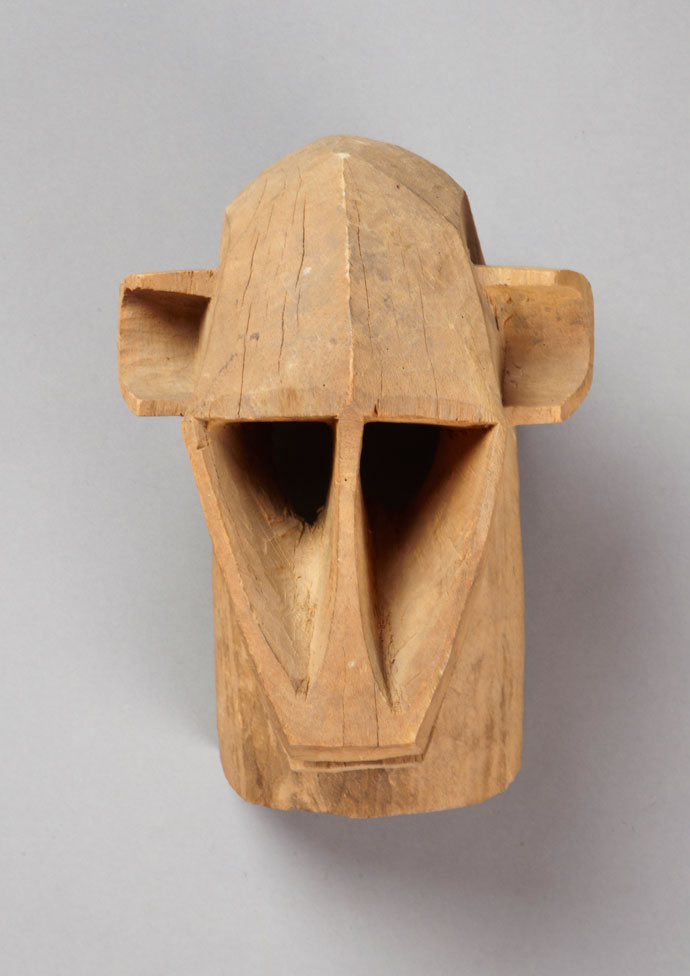 «Dege» Mask, Dogon, collected at Opti, Mali, in 1931, 'bois de tage', Musée du quai Branly.
«Dege» Mask, Dogon, collected at Opti, Mali, in 1931, 'bois de tage', Musée du quai Branly.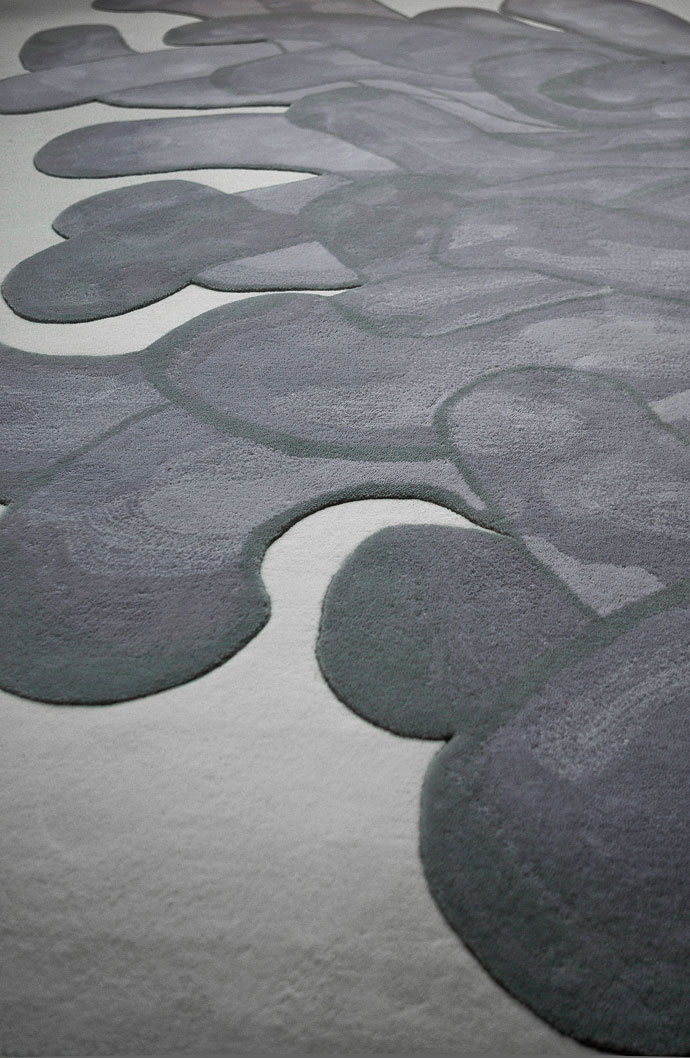 TAPIS PARADE - Anémones Jekyll, François Dumas, La Chance.
TAPIS PARADE - Anémones Jekyll, François Dumas, La Chance.
 Daedaleas, Fanny Dora © Charles Negre, ECAL 2011.
Daedaleas, Fanny Dora © Charles Negre, ECAL 2011.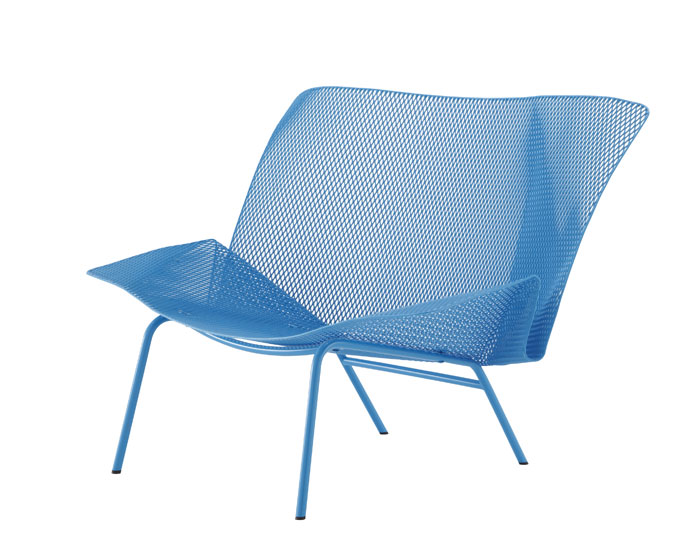 Grillage, fauteuil, François Azambourg, Ligne Roset © Jean-Pierre Lemoine.
Grillage, fauteuil, François Azambourg, Ligne Roset © Jean-Pierre Lemoine.Design Parade 7
Opening Friday June 29th
Until September 30th.
Villa Noailles, Hyères
Var – France. -

Astronomy compels the soul to look upward and leads us from this world to another – Plato
-Planet Earth is at the center of an observable universe with a 13.7 billion light year radius. Just so you get an idea of what that means, the Moon is only 0.0000000406 light years away (about 357,000km, if that makes it any easier). Paul Klauninger is an astrophotographer who captures some of the beauties of our galaxy, and has been doing so for over 20 years.
Astrophotography remains one of the most complicated forms of photography, but with today’s technology we get images not even Galileo or Newton would have even dreamt of. The Stimuleye catches up with Paul to get a better understanding on this ancient fascination for the Cosmos.
M45 - Pleiades Star Cluster. Photography by Paul Klauninger.
Miguel Batel: You must be happy winter is over. Last time we went out to the field must have been one of the coldest experiences I’ve ever had.
Paul Klauninger: I have mixed feelings about the winter really. While it can be very challenging to operate your equipment (and your fingers, for that matter) when it is –20o C, there are also a number of benefits. In the winter, the nights are much longer than the summer, so you can do much longer observing and imaging sessions. Also, the air tends to be cleaner, containing less dust and water vapour. That makes it better for imaging. And in the winter, you see a different part of the sky than in the summer, so you can see a completely different collection of celestial wonders. Finally, there are no mosquitoes or black flies in the winter, and that’s always a good thing.
MB: Being mostly subjects you can’t appreciate with your naked eye, or directly interact with, I’m curious to know what kind of emotional attachments you develop with your photographs?
PK: I guess my images are like a photo album of travel pictures, in that they remind me of places that I have visited. While it is true that most of the imaging subjects cannot be seen with the naked eye, my telescopes do in fact, allow me to see these without a camera.
When I look through a telescope at a nebula or galaxy that is thousands or millions of light-years away, I can’t help but wonder about other Earth-like planets in those places, and the potential for other advanced civilizations like our own. And when I see the images I’ve taken of those same places, they remind me of just how much more is out there that our limited vision cannot detect directly.
MB: Which have been some of your most significant or revealing photographs?
PK: One of my most favorite “revealing” images is one I took of the Pleiades star cluster. This is an object that you actually can see with the naked eye. It appears as a small dipper-like formation of seven very bright stars, just to the right of Orion. Not only does the image show these seven stars as brilliant blue beacons in the night, it shows hundreds of surrounding, lesser stars that are also part of that cluster. And the entire collection is wrapped in an ethereal, misty blue nebula. Photographically, it’s just a strikingly beautiful object.
Another favorite is actually a series of images that I took over a span of a few months of a very odd object in our solar system named Comet Holmes. Back in 2007, this dim, obscure little comet suddenly and explosively erupted. In a matter of 24 hours, its brightness increased by a million-fold and it easily became a naked-eye object. Before that, you would have needed a large telescope and sensitive camera to even capture it as dim speck of light. In the weeks after its eruption, it continued to expand and grow until it appeared larger than the full Moon, although nowhere near as bright. However, you could easily see this object as large round fuzzy patch in the sky. It wandered around the sky like that for months, until it gradually faded. I captured a series of images over that time period that nicely shows its growth and evolution. To this day, no one knows what caused this comet to erupt as it did.
Horsehead and Flame Nebulae. Photography by Paul Klauninger.
-

i am a very lazy man : yohji yamamoto
-“i am a very lazy man.”
That’s not really the first thing that comes to mind when you think about Japanese designer Yohji Yamamoto.
Film costume designer, Hyères jury president, Y-3 sportswear line creator, musician and soon film director, not to mention one of the people who revolutionized fashion aesthetics, Yamamoto has done his share.I had the pleasure of spending an evening backstage at his fashion show to get an exclusive peek for the new Joyce.com website.
Antoine Asseraf for Joyce.com, interview by Lucienne Leung.
Thanks: Coralie Gaultier, Filep Motwary.
-

The perfect muse: François Sagat
-In Carlo Collodi’s 1883 children’s novel “The Adventures of Pinocchio” it is the wooden puppet that possesses sentience prior to its transformation; it is the puppet and not its creator, the woodcarver who triggers the miracle of the doll coming alive.
With François one never knows who pulls the strings. It is him who invokes the sentiment for a story to become alive. Yet he hands himself over unconditionally to his collaborators, like an “instrument to be played”, as he likes to call it.
Film director Christopher Honoré once expressed that François Sagat “redefines the notion of masculinity”. François, the humble boy from Cognac has moulded himself to unattainable iconic status. Gilded with his blue inked crane, he is to conquer his righteous spot in the pantheon of pop culture…
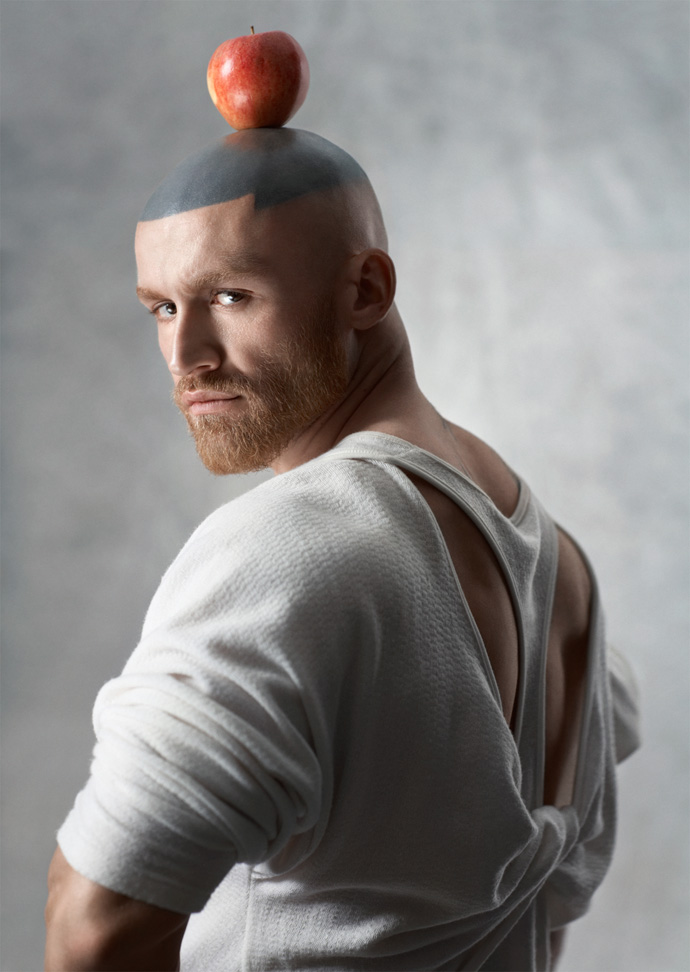 "François Sagat with Apple" Exhibition SPECTRE, Hyères 2010. Photography by René Habermacher
"François Sagat with Apple" Exhibition SPECTRE, Hyères 2010. Photography by René HabermacherRené Habermacher : you recently played alongside Chiara Mastroianni in HOMME AU BAIN by Christophe Honoré, and as well the lead in Bruce LaBruce L.A. ZOMBIE – how were your experiences?
François Sagat: L.A ZOMBIE was an experience which had very little to do with HOMME AU BAIN… The shoot for LA ZOMBIE was like a real porno shoot, scene by scene, it was mostly fucking, except that of course the porno version was censored for festivals…Beyond the sex scenes, LA ZOMBIE was a chaotic shoot, without a script, hasardous… but I’m still to this day satisfied with this participation and collaboration with Bruce LaBruce, from whom I still have much to learn, and who possesses a huge cinema and litterary culture… Despite what his critics say, I think Bruce has a real style.
During the shoot I really tested my capacity to resist “obstacles”, it was at times very difficult, I didn’t know where I was going, no direction, it was like being thrown in the lion’s den.
There was no script, the storytelling was weak and the whole plan was turned on its head by last minute changes and many cancelations, but that can be said about a lot of “cinema” projects.L'HOMME AU BAIN by Christophe Honoré, starring Chiara Mastroianni and François Sagat.
Regarding HOMME AU BAIN, the shooting was a lot more structured, but energetic nevertheless. It’s on this project that I realized that my abilities as an actor were limited, weak even, and felt like I was a big challenge for Christophe Honoré because of my “heavy” image, of the luggage I was carrying.
There were moments when I thought I terrified him, being everything except malleable. The project was constantly evolving due to the fact that we had planned it as a short, and that a lot of questions arose towards the end of shooting. It was finally released as a full feature film, and I have the feeling it wasn’t the right place for the film.It was an intimate project which to me, with hindsight, would have had a strong impact as a short. But I am neither director nor the creator of my own character. Rather than control the situation, I felt the blowback. But surely the imperfection of the final result makes it a real film, that can be remarked and criticized. I chose to shoot it and live the collaboration for the moment rather than think of the finished product.
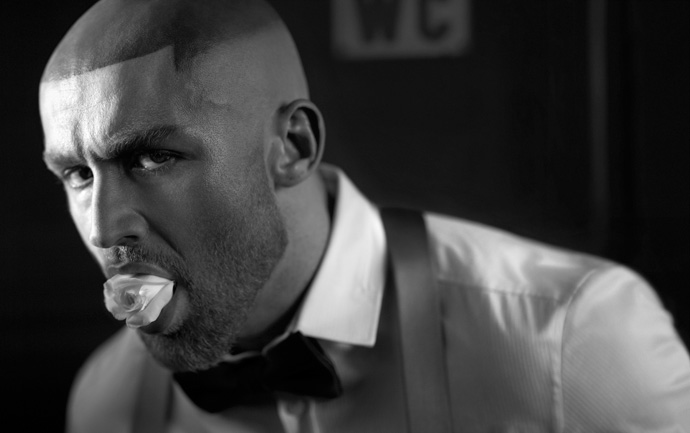 François Sagat for QVEST magazine. Photography by René Habermacher.
François Sagat for QVEST magazine. Photography by René Habermacher.What is the difference to you between acting in a porn movie or a feature film?
The difference ? Of course there are differences.
When you’re a porno actor, you’re in constant control of your carnal envelope and your physical aspect, whether you learn it or you have it from the start.
I didn’t know it as first but I am someone who has that ability. Porn is often an activity for people who are shy orally.
As a performer, you never really have to carry the more or less artistic responsabilities of a porn film, because there is no artistic issue to start with. You just have to be a good soldier fitting what the consumer desires to watch and what the production has decided, and that’s it.
I think also that I am someone who’s very sexual and exhibitiionist, but that’s not really giving you a scoop. Porn is like military service, it’s “my way or the highway”, and in my case, I’ve been and continue to be a good soldier.
The main difference is that you need a capacity to adapt and to lose who you really are, physically as well as morally. I created for myself a character in porn as in life, it’s difficult to let it go.
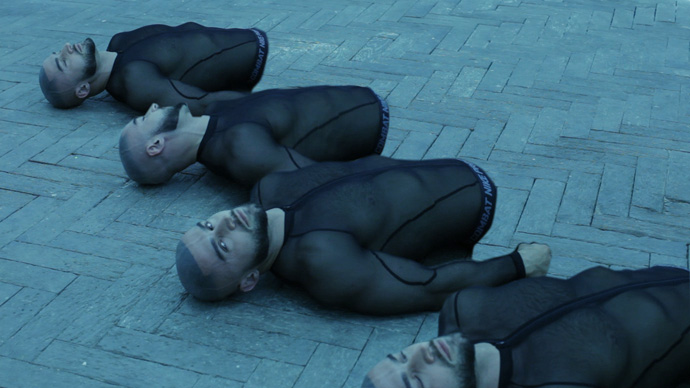 Video still from PILORI installation by Lynsey Peisinger & The Stimuleye. Villa Noailles, Hyères 2012.
Video still from PILORI installation by Lynsey Peisinger & The Stimuleye. Villa Noailles, Hyères 2012. -

films of the season: monsieur chypre – a short film with erotokritos
-The Stimuleye is proud to announce, with the support of Vogue Italia, an “erotic fashion epic” : Monsieur Chypre.
“HE KNOWS WOMEN, AND WOMEN KNOW HIM”
Erotokritos, it’s a strange name for a fashion brand.
It’s an even stranger name for a person.
And yet, he is truly called Erotokritos Antoniadis, named after the main protagonist of medieval epic poem, a hero “born from the labors of love”.
For 15 years, his label has been seducing women of all ages, drawn to collections that go back and forth between the sophistication of Paris and the dolce vita of Cyprus…"come and get it."
“THEY CALL HIM MONSIEUR CHYPRE”
France and Cyprus, Paris and Nicosia, it’s a long-distance couple.
In Monsieur Chypre, by Antoine Asseraf & René Habermacher, they come to life:
Loan Chabanol, channeling the nostalgia of Marguerite Duras’ The Lover, plays the tormented Parisian woman, cracking at the surface,
while Constantino Kouyialis, in his first first on-screen role, is a revelation as the seductive eponym hero, a modern day Alexis Zorbas.“AN EROTIC FASHION EPIC” we call it.
“Erotic,” how could it not be with a name like Erotokritos ?
“Fashion,” of course: stylist Michaela Dosamantes, fresh from winning Best Fashion Award at La Jolla Fashion Film Festival for La Main Dans Le Sac, mixes the season’s classic looks to capture the heroine’s transformation from “bluesy” in Vuitton to “red-hot” in Valentino.
And “epic” ? What else do you call a fashion film 10 months in the making, taking place not only in Paris but in numerous locations in Nicosia, in the salt lake facing the Hala Sultan Tekke mosque in Larnaca, in the Almyra and Anassa deluxe hotels, in small taverns by the side of the road, or in the majestic monument carved directed in the stone, the tomb of the Kings in Paphos ?“HIS VOICE IS A SONG”
All this, to the original soundtrack of Lori Schonberg and Shane Aspegren, members of Ça Va Chéri.
(Download it here).So, now the tough questions.
Is Cyprus really like this ? A little bit. Not at all. It depends how you look at it.
It is an island of freedom in the east mediterranean, where couples from Israel and Lebanon come to escape religion. It is the birthplace of Aphrodite. You go, you decide.So how can I meet this Mister Cyprus ? We hear that one a lot. From women (and men) of all ages. Maybe he’s real, maybe he’s a figment of our collective imagination, our repressed desires. One thing’s for sure — we can’t give you his number.
“ATTEMPTING TO CHARM HIM IS USELESS. HE IS THE ONE WHO WILL FIND.”
